TRENDNET TEW635-657 802.11N Wireless ADSL Router User Manual Wireless ADSL VPN Router
TRENDNET, Inc. 802.11N Wireless ADSL Router Wireless ADSL VPN Router
TRENDNET >
Contents
- 1. 635 user manual 1
- 2. 635 user manual 2
- 3. 657 user manual 1
- 4. 657 user manual 2
635 user manual 1
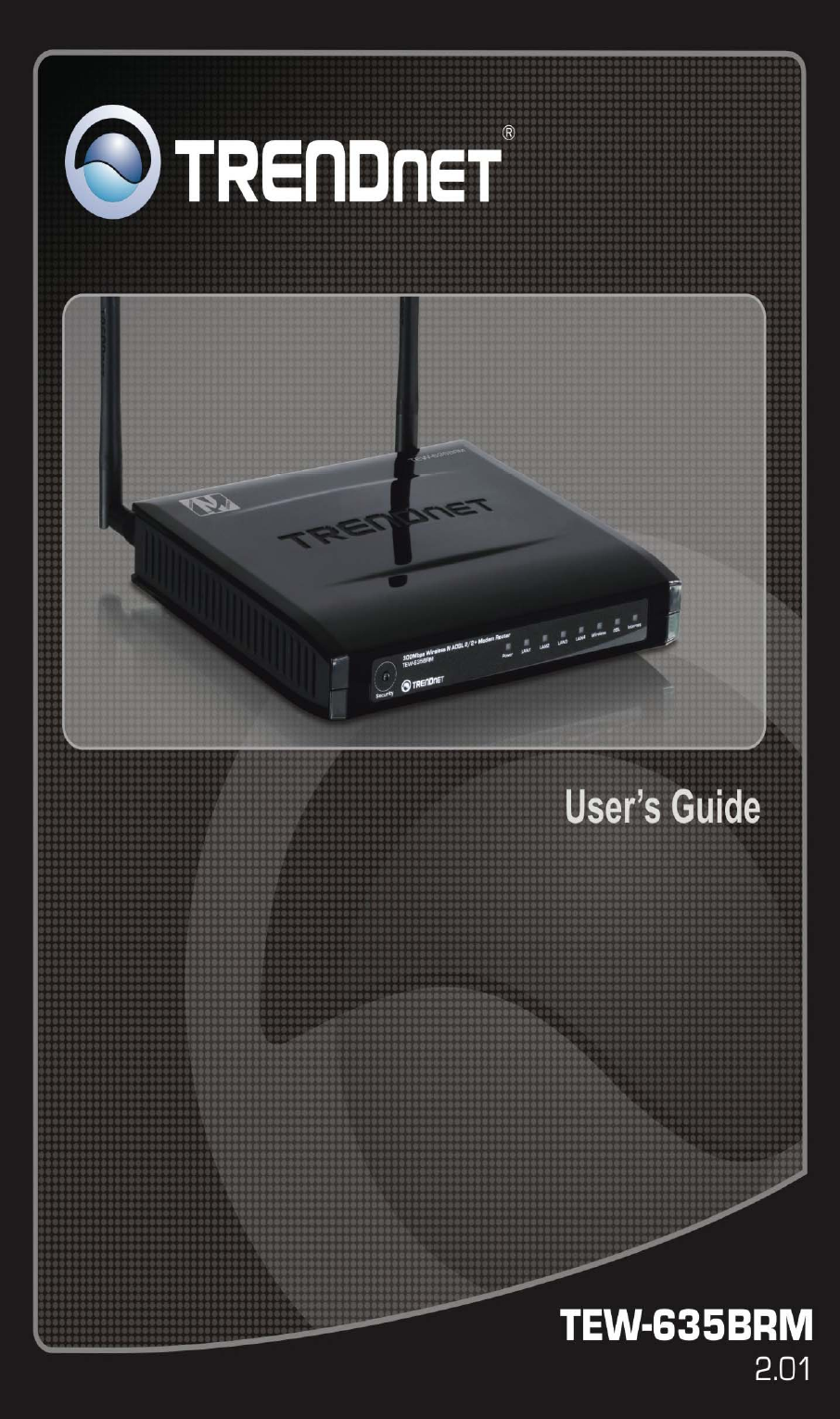
i

ii
Table of Contents
INTRODUCTION ..................................................................................................................... 1
Features .............................................................................................................................. 1
Package Contents .............................................................................................................. 3
Physical Details .................................................................................................................. 4
Wireless Performance Considerations ............................................................................ 6
PC CONFIGURATION ............................................................................................................ 7
Overview ............................................................................................................................ 7
Windows Clients ................................................................................................................ 7
Macintosh Clients ............................................................................................................ 17
Linux Clients .................................................................................................................... 17
Other Unix Systems ......................................................................................................... 17
Wireless Station Configuration ...................................................................................... 18
Wireless Configuration on Windows XP ....................................................................... 18
INSTALLATION .................................................................................................................... 27
Requirements ................................................................................................................... 27
Procedure ......................................................................................................................... 27
SETUP ...................................................................................................................................... 29
Overview .......................................................................................................................... 29
Configuration Program .................................................................................................. 30
Setup Wizard ................................................................................................................... 31
Home Screen .................................................................................................................... 34
LAN Screen ...................................................................................................................... 36
DHCP ............................................................................................................................... 37
Wireless Screen ................................................................................................................ 38
Wireless Security ............................................................................................................. 41
Trusted Wireless Stations ............................................................................................... 46
Password Screen .............................................................................................................. 48
Mode Screen ..................................................................................................................... 49
OPERATION AND STATUS ................................................................................................ 50
Operation - Router Mode ............................................................................................... 50
Status Screen .................................................................................................................... 50
Connection Status - PPPoE & PPPoA ........................................................................... 53
Connection Details - Dynamic IP Address .................................................................... 54
Connection Details - Fixed IP Address .......................................................................... 55
ADVANCED FEATURES ...................................................................................................... 56
Overview .......................................................................................................................... 56
Internet ............................................................................................................................. 56
Access Control ................................................................................................................. 59
Dynamic DNS (Domain Name Server) .......................................................................... 61
Options ............................................................................................................................. 63
Schedule............................................................................................................................ 64
Port Trigger ..................................................................................................................... 65
Port Forward ................................................................................................................... 67
Port Range Forward ....................................................................................................... 68
QoS ................................................................................................................................... 69
ADVANCED ADMINISTRATION ....................................................................................... 71
Overview .......................................................................................................................... 71
PC Database ..................................................................................................................... 72
Config File ........................................................................................................................ 76
Logs ................................................................................................................................... 77
E-mail ............................................................................................................................... 79
Diagnostics ....................................................................................................................... 81
Remote Administration ................................................................................................... 82
Routing ............................................................................................................................. 84
Upgrade Firmware .......................................................................................................... 88
MODEM MODE ..................................................................................................................... 89
Overview .......................................................................................................................... 89
Management Connections .............................................................................................. 89
Home Screen .................................................................................................................... 90
Mode Screen ..................................................................................................................... 91
Operation ......................................................................................................................... 91
Status Screen .................................................................................................................... 92
APPENDIX .............................................................................................................................. 94
Troubleshooting ............................................................................................................... 94
General Problems ............................................................................................................ 94
Internet Access ................................................................................................................. 94
Wireless Access ................................................................................................................ 95
About Wireless LANs ...................................................................................................... 96
BSS/ESS............................................................................................................................ 96
Channels ........................................................................................................................... 96
WEP .................................................................................................................................. 97
WPA-PSK ........................................................................................................................ 97
WPA2-PSK ...................................................................................................................... 97
WPA-802.1x ..................................................................................................................... 98
Wireless LAN Configuration .......................................................................................... 98
Specifications ................................................................................................................... 99
Regulatory Approvals ................................................................................................... 101
Limited Warranty ......................................................................................................... 102
P/N: 956YQN0001
Copyright © 2009. All Rights Reserved.
Document Version: 1.1
All trademarks and trade names are the properties of their respective owners.
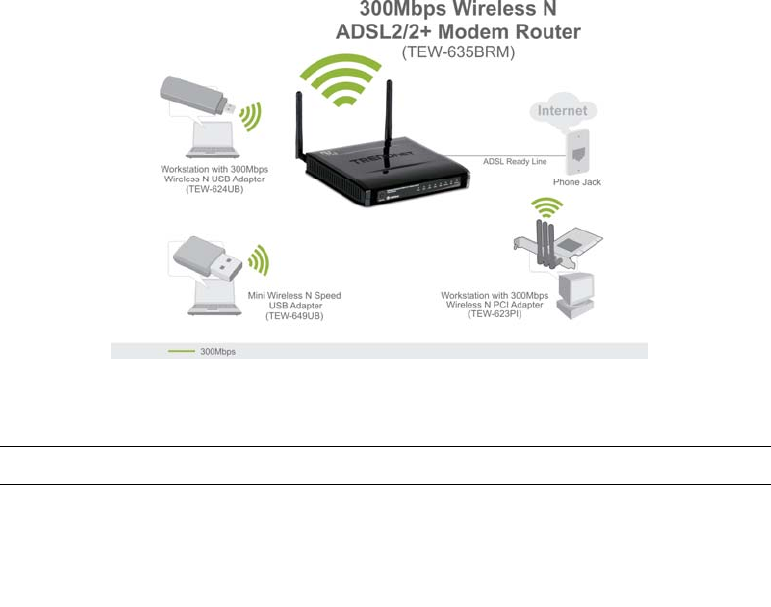
1
Introduction
Congratulations on the purchase of your new TEW-635BRM. The 300Mbps Wireless N
ADSL 2/2+ Modem Router is a multi-function device providing the following services:
• ADSL Modem.
• Shared Broadband Internet Access for all LAN users.
• Wireless Access Point for 802.11b, 802.11g and 802.11n Wireless Stations.
• 4-Port Switching Hub for 10BaseT or 100BaseT connections.
Features
The 300Mbps Wireless N ADSL 2/2+ Modem Router incorporates many advanced features,
carefully designed to provide sophisticated functions while being easy to use.
Internet Access Features
• Shared Internet Access. All users on the LAN or WLAN can access the Internet
through the Wireless ADSL Router, using only a single external IP Address. The local
(invalid) IP Addresses are hidden from external sources. This process is called NAT
(Network Address Translation).
• Built-in ADSL Modem. The Wireless ADSL Router has a built-in ADSL modem,
supporting all common ADSL connections.
• IPoA, PPPoE, PPPoA, Direct Connection Support. The Wireless ADSL Router
supports all common connection methods.
• Auto-detection of Internet Connection Method. In most situations, the Wireless
ADSL Router can test your ADSL and Internet connection to determine the connection
method used by your ISP.
• Fixed or Dynamic IP Address. On the Internet (ADSL port) connection, the Wireless
ADSL Router supports both Dynamic IP Address (IP Address is allocated on connection)
and Fixed IP Address.

2
Advanced Internet Functions
• Application Level Gateways (ALGs). Applications which use non-standard connec-
tions or port numbers are normally blocked by the Firewall. The ability to define and
allow such applications is provided, to enable such applications to be used normally.
• Dynamic DNS Support. DDNS, when used with the Virtual Servers feature, allows
users to connect to Servers on your LAN using a Domain Name, even if you have a dy-
namic IP address which changes every time you connect.
• URL Filter. Use the URL Filter to block access to undesirable Web sites by LAN users.
• Access Control. Using the Access Control feature, you can assign LAN users to differ-
ent groups, and determine which Internet services are available to each group.
• Firewall. As well as the built-in firewall to protect your LAN, you can define Firewall
Rules to determine which incoming and outgoing traffic should be permitted.
• Scheduling. Both the URL Filter and Firewall rules can be scheduled to operate only at
certain times. This provides great flexibility in controlling Internet -bound traffic.
• Logs. Define what data is recorded in the Logs, and optionally send log data to a Syslog
Server. Log data can also be E-mailed to you.
• Port Triggering. This feature, also called Special Applications, allows you to use
Internet applications which normally do not function when used behind a firewall.
• Port Forwarding. This feature allows Internet users to access Internet servers on your
LAN. The required setup is quick and easy.
• QoS Support Quality of Service can be used to handle packets so that more important
connections receive priority over less important one.
• VPN Pass through Support. PCs with VPN (Virtual Private Networking) software
using PPTP, L2TP and IPSec are transparently supported - no configuration is required.
Wireless Features
• Standards Compliant. The Wireless ADSL Router complies with the IEEE802.11g
(DSSS) specifications for Wireless LANs.
• Supports 11n Wireless Stations. The 802.11n Draft standard provides for backward
compatibility with the 802.11b standard, so 802.11n, 802.11b and 802.11g Wireless sta-
tions can be used simultaneously.
• WEP support. Support for WEP (Wired Equivalent Privacy) is included. Key sizes of
64 Bit and 128 Bit are supported. WEP encrypts any data before transmission, providing
protection against snoopers.
• WPA-PSK support. Like WEP, WPA-PSK encrypts any data before transmission,
providing protection against snoopers. The WPA-PSK is a later standard than WEP, and
provides both easier configuration and greater security than WEP.
• WPA2-PSK support. Support for WPA2 is also included. WPA2 uses the extremely
secure AES encryption method.
• 802.1x Support. Support for 802.1x mode is included, providing for the industrial-
strength wireless security of 802.1x authentication and authorization.
• Wireless MAC Access Control. The Wireless Access Control feature can check the
MAC address (hardware address) of Wireless stations to ensure that only trusted Wireless
Stations can access your LAN.
• WPS Support. WPS (Wi-Fi Protected Setup) can simplify the process of connecting any
device to the wireless network by using the push button configuration (PBC) on the Wire-
less Access Point, or entering PIN code if there's no button.
• WDS Support. Support for WDS (Wireless Distribution System) allows the Wireless
Access Point to act as a Wireless Bridge. Both Point-to-Point and Multi-Point Bridge
modes are supported.

• Simple Configuration. If the default settings are unsuitable, they can be changed
quickly and easily.
LAN Features
• 4-Port Switching Hub. The Wireless ADSL Router incorporates a 4-port 10/100BaseT
switching hub, making it easy to create or extend your LAN.
• DHCP Server Support. Dynamic Host Configuration Protocol provides a dynamic IP
address to PCs and other devices upon request. The Wireless ADSL Router can act as a
DHCP Server for devices on your local LAN and WLAN.
Configuration & Management
• Easy Setup. Use your WEB browser from anywhere on the LAN or WLAN for configu-
ration.
• Configuration File Upload/Download. Save (download) the configuration data from
the Wireless ADSL Router to your PC, and restore (upload) a previously-saved configura-
tion file to the Wireless ADSL Router.
• Remote Management. The Wireless ADSL Router can be managed from any PC on
your LAN or Wireless LAN. And, if the Internet connection exists, it can also (optionally)
be configured via the Internet.
• Network Diagnostics. You can use the Wireless ADSL Router to perform a Ping or
DNS lookup.
Security Features
• Password - protected Configuration. Password protection is provided to prevent
unauthorized users from modifying the configuration data and settings.
• Wireless LAN Security. WPA-PSK, WEP and Wireless access control by MAC ad-
dress are all supported. The MAC-level access control feature can be used to prevent
unknown wireless stations from accessing your LAN.
• NAT Protection. An intrinsic side effect of NAT (Network Address Translation) tech-
nology is that by allowing all LAN users to share a single IP address, the location and
even the existence of each PC is hidden. From the external viewpoint, there is no network,
only a single device - the Wireless ADSL Router.
• Firewall. All incoming data packets are monitored and all incoming server requests are
filtered, thus protecting your network from malicious attacks from external sources.
• Protection against DoS attacks. DoS (Denial of Service) attacks can flood your
Internet connection with invalid packets and connection requests, using so much band-
width and so many resources that Internet access becomes unavailable. The Wireless
ADSL Router incorporates protection against DoS attacks.
Package Contents
The following items should be included. If any of these items are damaged or missing, please
contact your dealer immediately.
• TEW-635BRM
• CD-ROM (User’s Guide)
• Quick Installation Guide
• Power adapter (12V DC, 1A)
• Cat. 5 Ethernet cable (1.5m / 5ft.)
• RJ-11 telephone cable (0.9m / 3ft.)
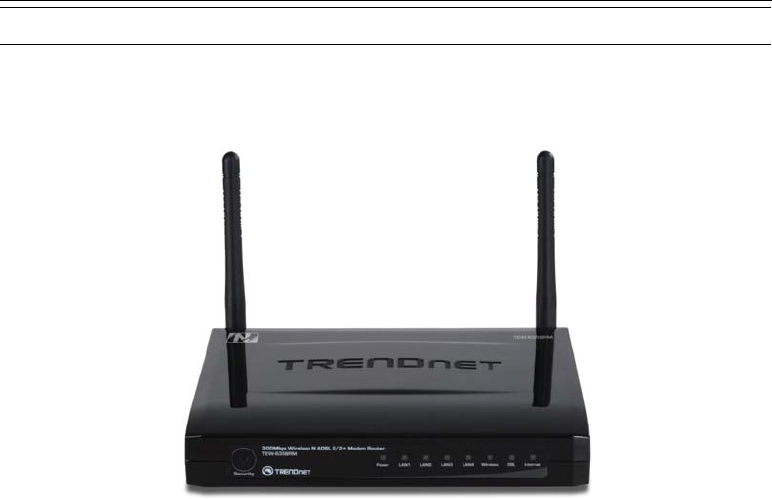
Physical Details
Front-mounted LEDs
WPS Button Push the WPS button on the device and your other wireless device to
perform WPS function that easily creates an encryption-secured wireless
connection automatically.
When WPS button is pressed, the LED will start blinking for 2 minutes. If
any client is associated with the router successfully within 2 minutes, the
LED will stay On, otherwise the LED will be Off.
Power LED
(Orange) On - Power on.
Off - No power.
LAN (Blue) On - The LAN port is active.
Off - No active connection on the LAN (Ethernet) port.
Flashing - Data is being transmitted or received via the corresponding
LAN port.
WLAN (Blue) On - When wireless client have connected
Off - No Wireless connections currently exist.
Flashing - Data is being transmitted or received via the Wireless access
point. This includes "network traffic" as well as user data.
ADSL
(Green) On - ADSL connection established.
Off - No ADSL connection currently exists.
Flashing - ADSL is synchronizing.
Internet
(Blue/Yellow) On (Blue) - Internet connection is available.
Off - No Internet connection available.
Flashing (Blue) - Data is being transmitted or received via the ADSL
connection.
85B
4
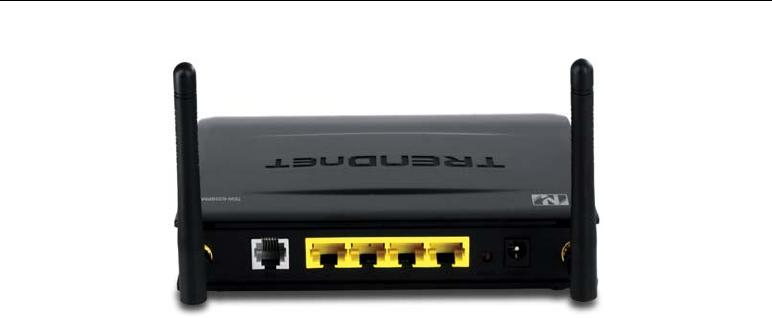
Rear Panel
ADSL port Connect this port to your ADSL line.
10/100BaseT
LAN connections Use standard LAN cables (RJ45 connectors) to connect your PCs to
these ports.
Note:
Any LAN port on the Wireless ADSL Router will automatically
function as an "Uplink" port when required. Just connect any port to
a normal port on the other hub, using a standard LAN cable.
Reset Button
(Reset to Defaults) This button will reset the Wireless ADSL Router to the factory
default settings.
To do this, press and hold the Reset Button for five (5) seconds, until
the Status LED is lit, then release the Reset Button, and wait the
Wireless ADSL Router to restart using the factory default values.
Power port Connect the supplied power adapter here.

6
Wireless Performance Considerations
There are a number of factors that can impact the range of wireless devices.
1. Adjust your wireless devices so that the signal is traveling in a straight path, rather than at
an angle. The more material the signal has to pass through the more signal you will lose.
2. Keep the number of obstructions to a minimum. Each obstruction can reduce the range of
a wireless device. Position the wireless devices in a manner that will minimize the amount
of obstructions between them.
3. Building materials can have a large impact on your wireless signal. In an indoor environ-
ment, try to position the wireless devices so that the signal passes through less dense
material such as dry wall. Dense materials like metal, solid wood, glass or even furniture
may block or degrade the signal.
4. Antenna orientation can also have a large impact on your wireless signal. Use the wireless
adapter’s site survey tool to determine the best antenna orientation for your wireless de-
vices.
5. Interference from devices that produce RF (radio frequency) noise can also impact your
signal. Position your wireless devices away from anything that generates RF noise, such as
microwaves, radios and baby monitors.
6. Any device operating on the 2.4GHz frequency will cause interference. Devices such as
2.4GHz cordless phones or other wireless remotes operating on the 2.4GHz frequency can
potentially drop the wireless signal. Although the phone may not be in use, the base can
still transmit wireless signal. Move the phone’s base station as far away as possible from
your wireless devices.
If you are still experiencing low or no signal consider repositioning the wireless devices or
installing additional access points. The use of higher gain antennas may also provide the
necessary coverage depending on the environment.

PC Configuration
Overview
For each PC, the following may need to be configured:
• TCP/IP network settings
• Internet Access configuration
• Wireless configuration
Windows Clients
This section describes how to configure Windows clients for Internet access via the Wireless
ADSL Router.
The first step is to check the PC's TCP/IP settings.
The Wireless ADSL Router uses the TCP/IP network protocol for all functions, so it is essen-
tial that the TCP/IP protocol be installed and configured on each PC.
TCP/IP Settings - Overview
If using the default Wireless ADSL Router settings, and the default Win-
dows TCP/IP settings, no changes need to be made.
• By default, the Wireless ADSL Router will act as a DHCP Server, automatically providing
a suitable IP Address (and related information) to each PC when the PC boots.
• For all non-Server versions of Windows, the default TCP/IP setting is to act as a DHCP
client.
If using a Fixed (specified) IP address, the following changes are re-
quired:
• The Gateway must be set to the IP address of the Wireless ADSL Router
• The DNS should be set to the address provided by your ISP.
If your LAN has a Router, the LAN Administrator must re-
configure the Router itself. Refer to Chapter 8 - Ad-
vanced Setup for details.
87B
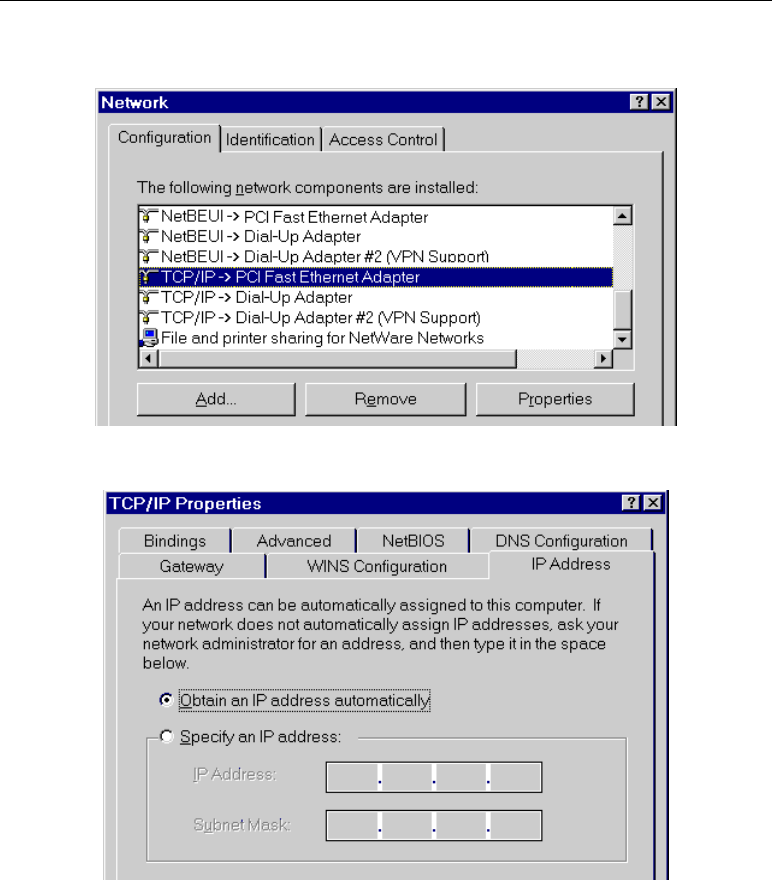
Checking TCP/IP Settings - Windows 9x/ME:
1. Select Control Panel - Network. You should see a screen like the following:
2. Select the TCP/IP protocol for your network card.
3. Click on the Properties button. You should then see a screen like the following.
Ensure your TCP/IP settings are correct, as follows:
Using DHCP
To use DHCP, select the radio button Obtain an IP Address automatically. This is the default
Windows setting. Using this is recommended. By default, the Wireless ADSL Router will act
as a DHCP Server.
Restart your PC to ensure it obtains an IP Address from the Wireless ADSL Router.
Using "Specify an IP Address"
If your PC is already configured, check with your network administrator before making the
following changes:
• On the Gateway tab, enter the Wireless ADSL Router's IP address in the New Gateway
field and click Add, as shown below. Your LAN administrator can advise you of the IP
Address they assigned to the Wireless ADSL Router.
8
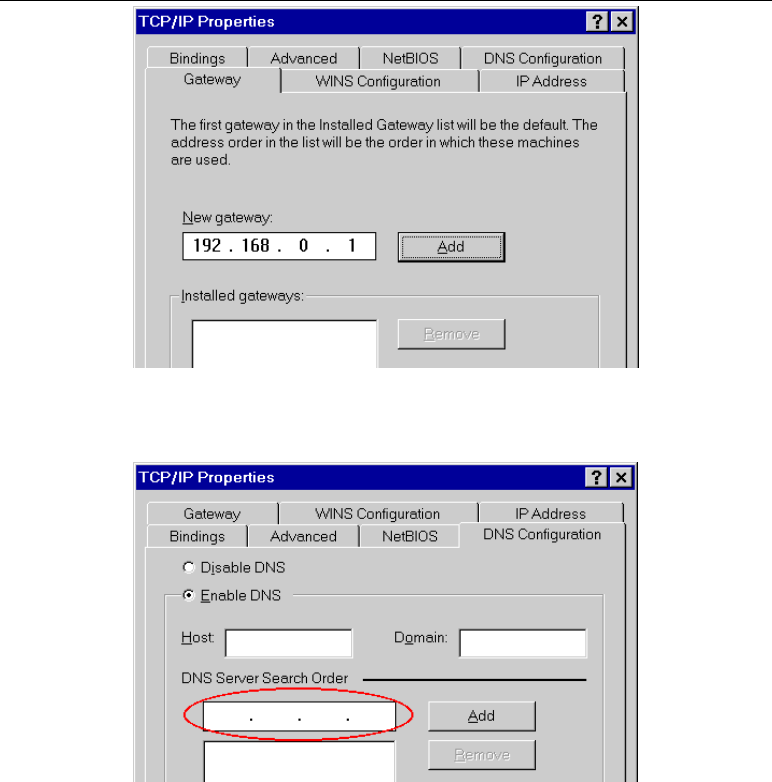
• On the DNS Configuration tab, ensure Enable DNS is selected. If the DNS Server Search
Order list is empty, enter the DNS address provided by your ISP in the fields beside the
Add button, then click Add.
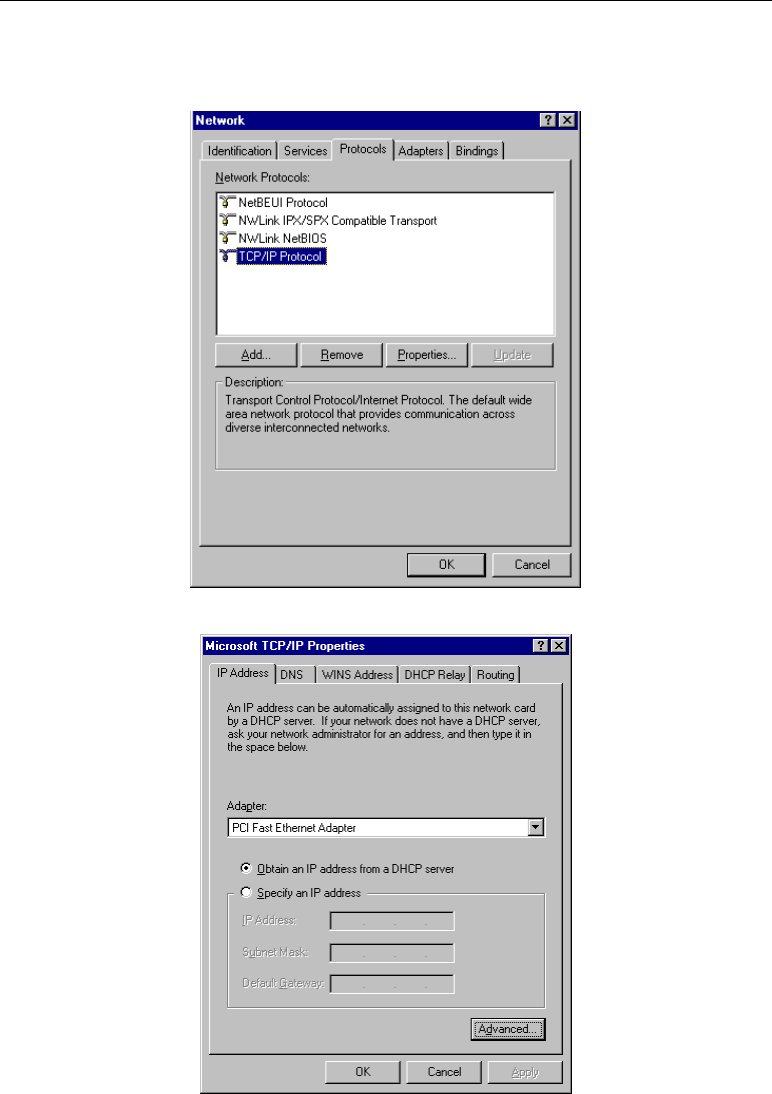
Checking TCP/IP Settings - Windows NT4.0
1. Select Control Panel - Network, and, on the Protocols tab, select the TCP/IP protocol, as
shown below.
2. Click the Properties button to see a screen like the one below.
3. Select the network card for your LAN.
4. Select the appropriate radio button - Obtain an IP address from a DHCP Server or Specify
an IP Address, as explained below.
Obtain an IP address from a DHCP Server
This is the default Windows setting. Using this is recommended. By default, the Wireless
ADSL Router will act as a DHCP Server.
Restart your PC to ensure it obtains an IP Address from the Wireless ADSL Router.
10
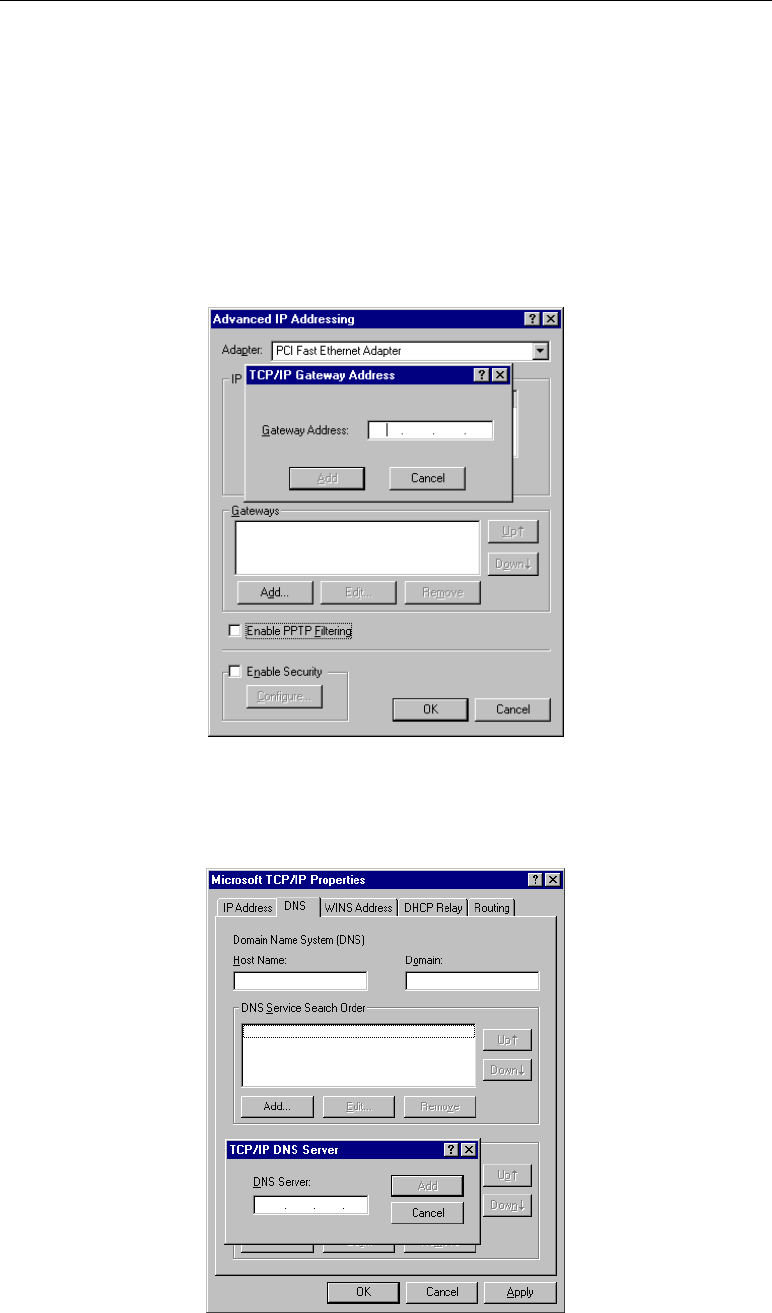
Specify an IP Address
If your PC is already configured, check with your network administrator before making the
following changes.
1. The Default Gateway must be set to the IP address of the Wireless ADSL Router. To set
this:
• Click the Advanced button on the screen above.
• On the following screen, click the Add button in the Gateways panel, and enter the
Wireless ADSL Router's IP address, as shown in Figure 26 below.
• If necessary, use the Up button to make the Wireless ADSL Router the first entry in
the Gateways list.
to the address provided by your ISP, as fo2. The DNS should be set lows:
shown below, click the Add button (under DNS Service Search
l
• Click the DNS tab.
• On the DNS screen,
Order), and enter the DNS provided by your ISP.
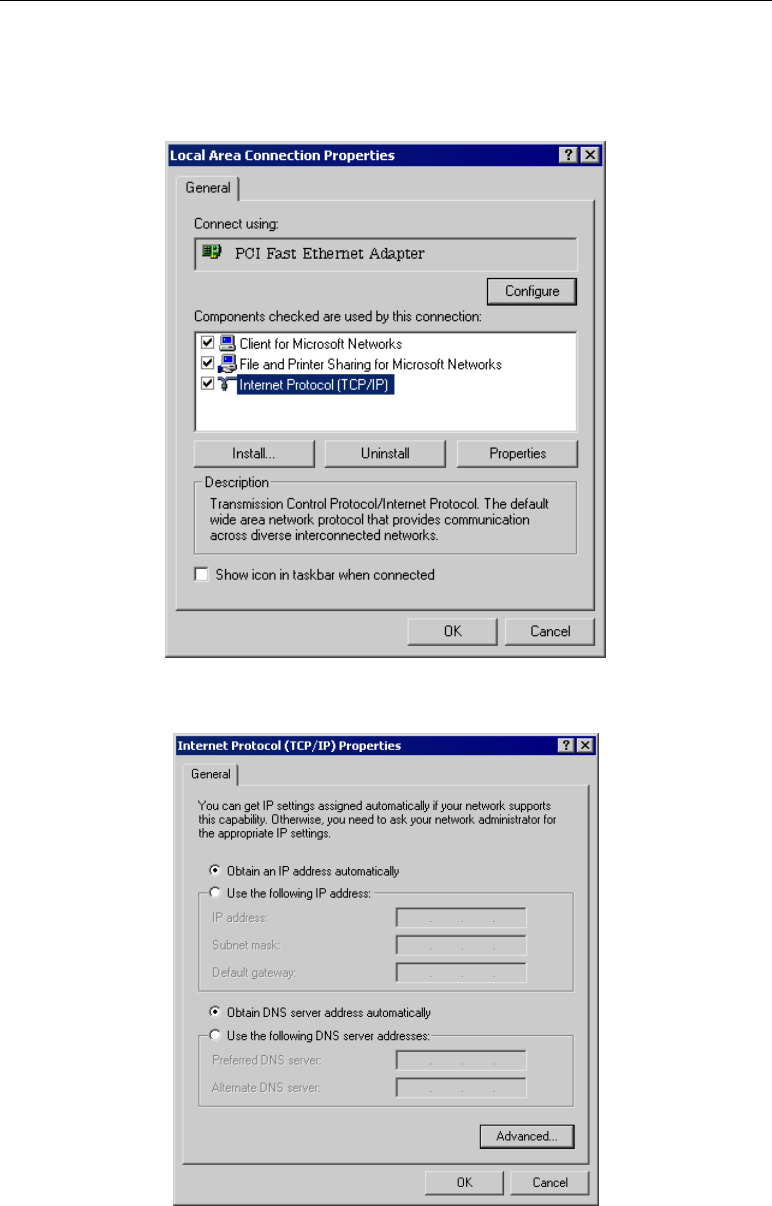
Checking TCP/IP Settings - Windows 2000:
1. Select Control Panel - Network and Dial-up Connection.
2. Right - click the Local Area Connection icon and select Properties. You should see a
screen like the following:
3. Select the TCP/IP protocol for your network card.
4. Click on the Properties button. You should then see a screen like the following.
5. Ensure your TCP/IP settings are correct, as described below.
Using DHCP
To use DHCP, select the radio button Obtain an IP Address automatically. This is the default
Windows setting. Using this is recommended. By default, the Wireless ADSL Router will act
as a DHCP Server.
12

Restart your PC to ensure it obtains an IP Address from the Wireless ADSL Router.
Using a fixed IP Address ("Use the following IP Address")
If your PC is already configured, check with your network administrator before making the
following changes.
• Enter the Wireless ADSL Router's IP address in the Default gateway field and click OK.
(Your LAN administrator can advise you of the IP Address they assigned to the Wireless
ADSL Router.)
• If the DNS Server fields are empty, select Use the following DNS server addresses, and
enter the DNS address or addresses provided by your ISP, then click OK.
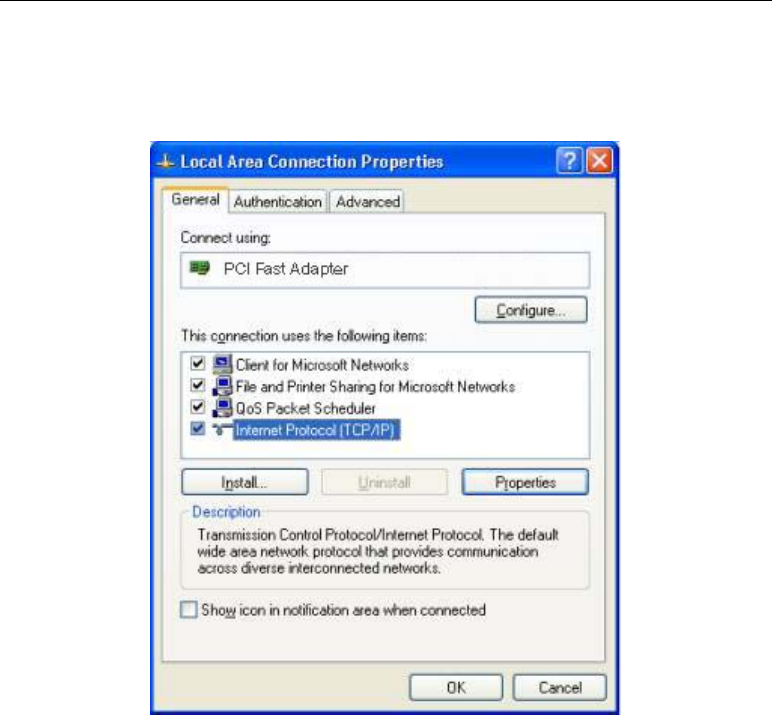
Checking TCP/IP Settings - Windows XP
1. Select Control Panel - Network Connection.
2. Right click the Local Area Connection and choose Properties. You should see a screen
like the following:
3. Select the TCP/IP protocol for your network card.
4. Click on the Properties button. You should then see a screen like the following.
14
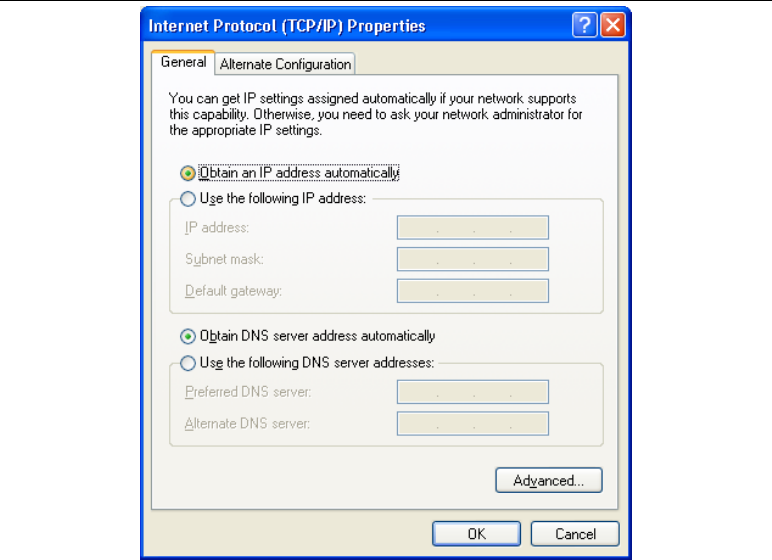
5. Ensure your TCP/IP settings are correct.
Using DHCP
To use DHCP, select the radio button Obtain an IP Address automatically. This is the default
Windows setting. Using this is recommended. By default, the Wireless ADSL Router will act
as a DHCP Server.
Restart your PC to ensure it obtains an IP Address from the Wireless ADSL Router.
Using a fixed IP Address ("Use the following IP Address")
If your PC is already configured, check with your network administrator before making the
following changes.
• In the Default gateway field, enter the Wireless ADSL Router's IP address and click OK.
Your LAN administrator can advise you of the IP Address they assigned to the Wireless
ADSL Router.
• If the DNS Server fields are empty, select Use the following DNS server addresses, and
enter the DNS address or addresses provided by your ISP, then click OK.

16
Internet Access
To configure your PCs to use the Wireless ADSL Router for Internet access:
• Ensure that the DSL modem, Cable modem, or other permanent connection is functional.
• Use the following procedure to configure your Browser to access the Internet via the LAN,
rather than by a Dial-up connection.
For Windows 9x/ME/2000
1. Select Start Menu - Settings - Control Panel - Internet Options.
2. Select the Connection tab, and click the Setup button.
3. Select "I want to set up my Internet connection manually, or I want to connect through a
local area network (LAN)" and click Next.
4. Select "I connect through a local area network (LAN)" and click Next.
5. Ensure all of the boxes on the following Local area network Internet Configuration screen
are unchecked.
6. Check the "No" option when prompted "Do you want to set up an Internet mail account
now?".
7. Click Finish to close the Internet Connection Wizard.
Setup is now completed.
For Windows XP
1. Select Start Menu - Control Panel - Network and Internet Connections.
2. Select Set up or change your Internet Connection.
3. Select the Connection tab, and click the Setup button.
4. Cancel the pop-up "Location Information" screen.
5. Click Next on the "New Connection Wizard" screen.
6. Select "Connect to the Internet" and click Next.
7. Select "Set up my connection manually" and click Next.
8. Check "Connect using a broadband connection that is always on" and click Next.
9. Click Finish to close the New Connection Wizard.
Setup is now completed.
Accessing AOL
To access AOL (America On Line) through the Wireless ADSL Router, the AOL for Windows
software must be configured to use TCP/IP network access, rather than a dial-up connection.
The configuration process is as follows:
• Start the AOL for Windows communication software. Ensure that it is Version 2.5, 3.0 or
later. This procedure will not work with earlier versions.
• Click the Setup button.
• Select Create Location, and change the location name from "New Locality" to "Wireless
ADSL Router".
• Click Edit Location. Select TCP/IP for the Network field. (Leave the Phone Number
blank.)
• Click Save, then OK.
Configuration is now complete.
• Before clicking "Sign On", always ensure that you are using the "Wireless ADSL Router"
location.

Macintosh Clients
From your Macintosh, you can access the Internet via the Wireless ADSL Router. The proce-
dure is as follows.
1. Open the TCP/IP Control Panel.
2. Select Ethernet from the Connect via pop-up menu.
3. Select Using DHCP Server from the Configure pop-up menu. The DHCP Client ID field
can be left blank.
4. Close the TCP/IP panel, saving your settings.
Note:
If using manually assigned IP addresses instead of DHCP, the required changes are:
• Set the Router Address field to the Wireless ADSL Router's IP Address.
• Ensure your DNS settings are correct.
Linux Clients
To access the Internet via the Wireless ADSL Router, it is only necessary to set the Wireless
ADSL Router as the "Gateway".
Ensure you are logged in as "root" before attempting any changes.
Fixed IP Address
By default, most Unix installations use a fixed IP Address. If you wish to continue using a
fixed IP Address, make the following changes to your configuration.
• Set your "Default Gateway" to the IP Address of the Wireless ADSL Router.
• Ensure your DNS (Name server) settings are correct.
To act as a DHCP Client (recommended)
The procedure below may vary according to your version of Linux and X -windows shell.
1. Start your X Windows client.
2. Select Control Panel - Network
3. Select the "Interface" entry for your Network card. Normally, this will be called "eth0".
4. Click the Edit button, set the "protocol" to "DHCP", and save this data.
5. To apply your changes
• Use the "Deactivate" and "Activate" buttons, if available.
• OR, restart your system.
Other Unix Systems
To access the Internet via the Wireless ADSL Router:
• Ensure the "Gateway" field for your network card is set to the IP Address of the Wireless
ADSL Router.
• Ensure your DNS (Name Server) settings are correct.
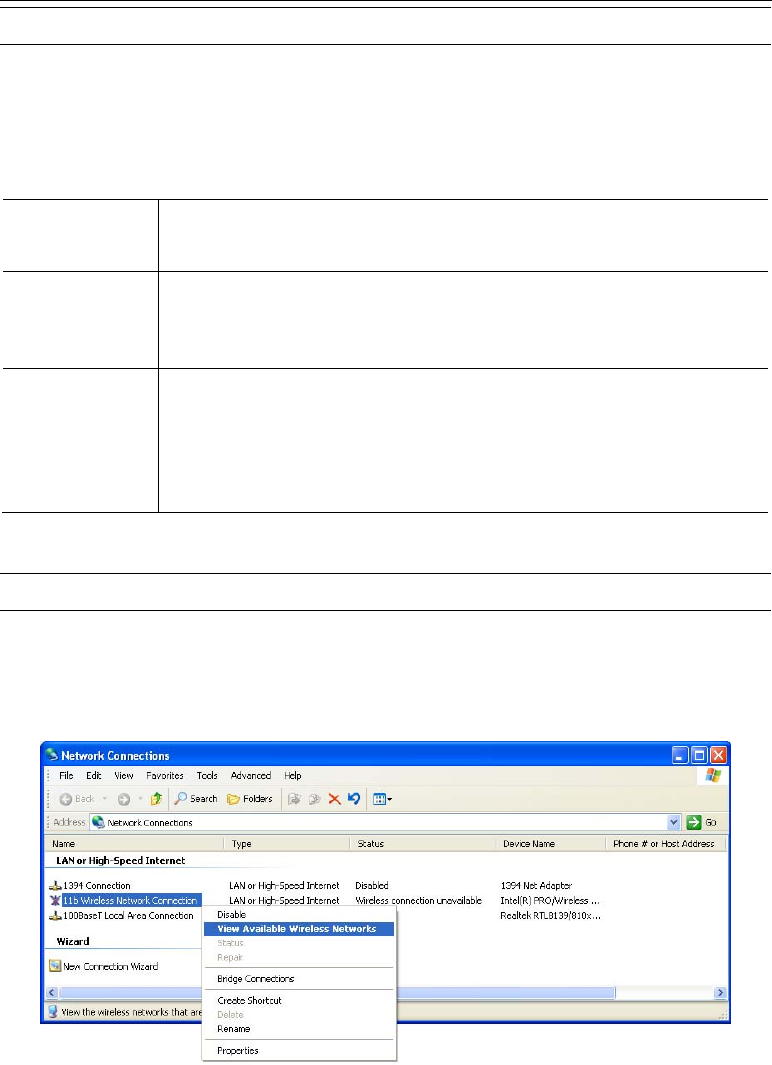
Wireless Station Configuration
This section applies to all Wireless stations wishing to use the Wireless ADSL Router's Access
Point, regardless of the operating system which is used on the client.
To use the Wireless Access Point in the Wireless ADSL Router, each Wireless Station must
have compatible settings, as follows:
Mode The mode must be set to Infrastructure (rather than Ad-hoc)
Access points only operate in Infrastructure mode.
SSID (ESSID) This must match the value used on the Wireless ADSL Router. The
default value is Admin.
Note! The SSID is case sensitive.
Wireless
Security By default, Wireless security on the Wireless ADSL Router is disabled.
• If Wireless security remains disabled on the Wireless ADSL Router,
all stations must have wireless security disabled.
• If Wireless security is enabled on the Wireless Router, each station
must use the same settings as the Wireless ADLS Router.
19B
Wireless Configuration on Windows XP
If using Windows XP to configure the Wireless interface on your PC, the configuration proce-
dure is as follows:
1. Open the Network Connections folder. (Start - Settings - Network Connections).
2. Right-click the Wireless Network Connection, check that it is enabled (menu option says
Disable, rather than Enable) and then select View Available Wireless Networks.
3. You will then see a list of wireless networks.
18
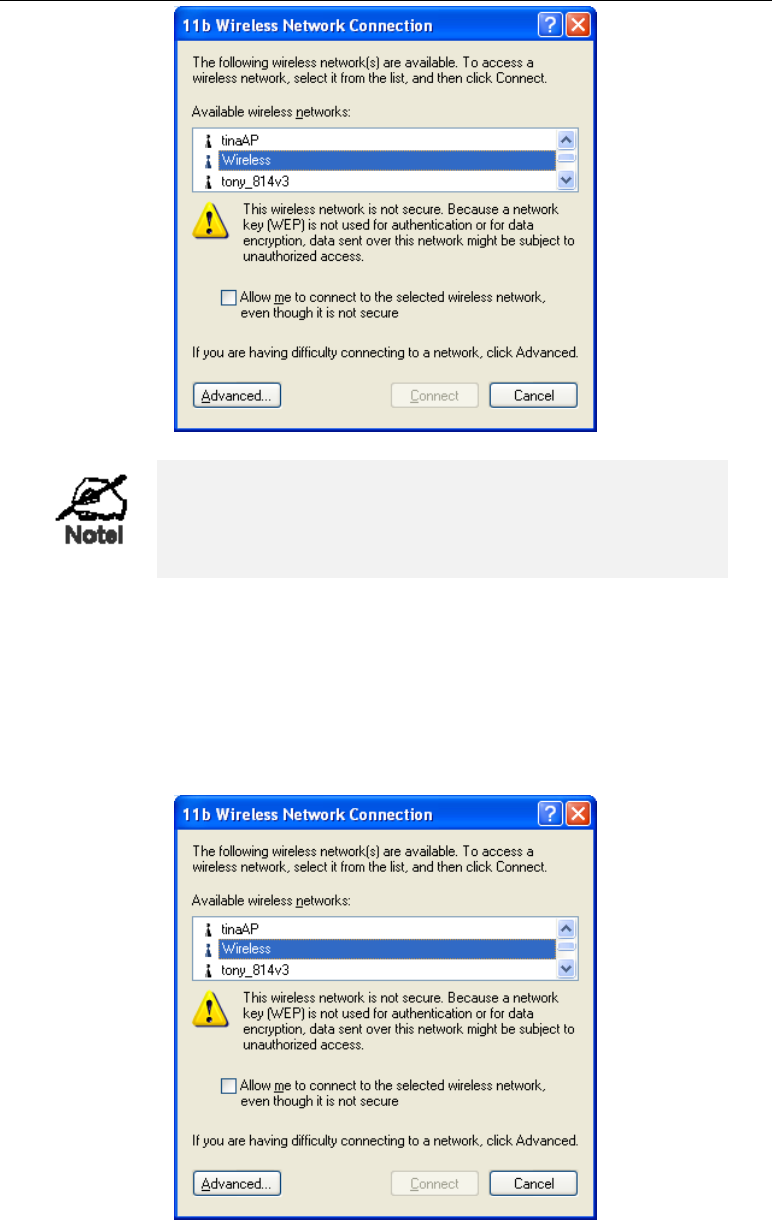
If the "Broadcast SSID" setting on the Wireless ADSL
Router has been disabled, its SSID will NOT be listed.
See the following section "If the SSID is not listed" for
details of dealing with this situation.
4. The next step depends on whether or not Wireless security has been enabled on the Wire-
less ADSL Router.
If Wireless Security is Disabled
If Wireless security on the Wireless ADSL Router is disabled, Windows will warn you that the
Wireless network is not secure.
To connect:
• Check the checkbox Allow me to connect to the selected wireless network, even though it
is not secure.
• The Connect button will then be available. Click the Connect button, and wait a few
seconds for the connection to be established.
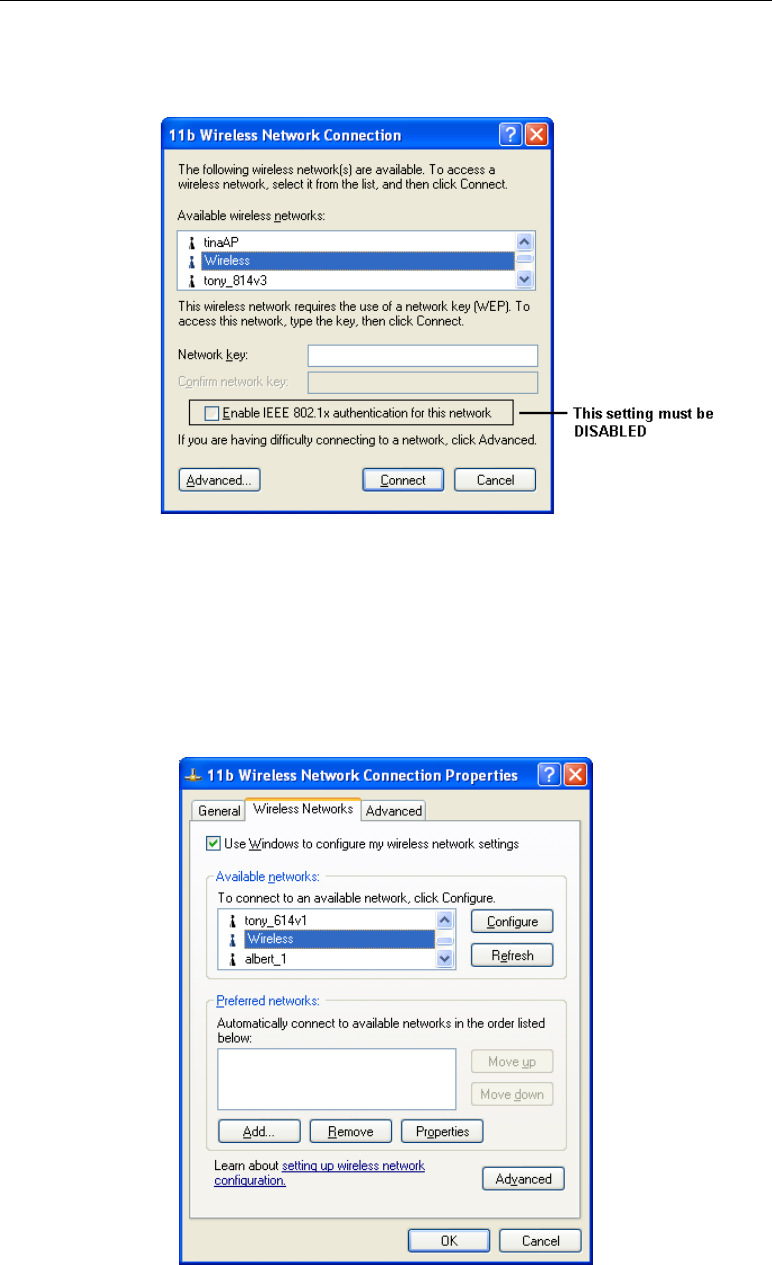
If using WEP Data Encryption
If WEP data encryption has been enabled on the Wireless ADSL Router, Windows will detect
this, and show a screen like the following.
To connect:
• Enter the WEP key, as set on the Wireless ADSL Router, in the Network Key field.
• Re-enter the WEP key into the Confirm Network key field.
• Disable the checkbox Enable IEEE 802.1x authentication for this network.
• Click the Connect button.
If this fails, click the Advanced button, to see a screen like the following:
Select the SSID for the Wireless ADSL Router, and click Configure, to see a screen like the
following:
20
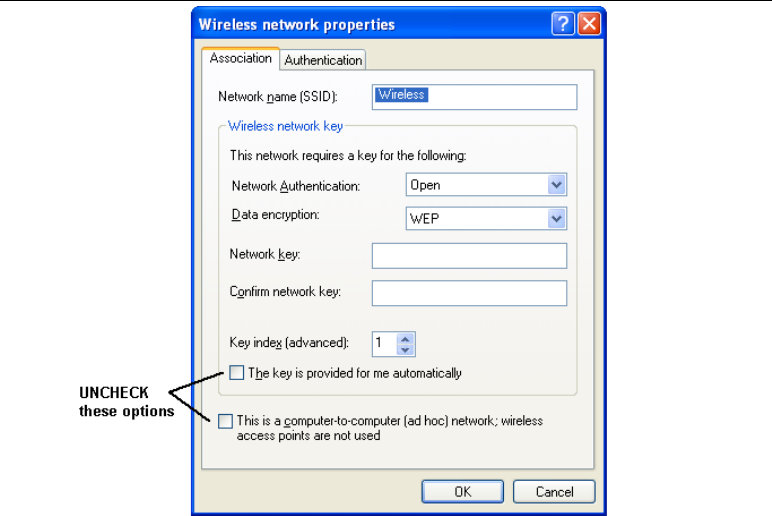
Configure this screen as follows:
• Set Network Authentication to match the Wireless ADSL Router. (If the setting on the
Wireless ADSL Router is "Auto", then either Open or Shared can be used.)
• For Data Encryption, select WEP.
• For the Network key and Confirm network key, enter the default key value used on the
Wireless ADSL Router. (Windows will determine if 64bit or 128bit encryption is used.)
• The Key index must match the default key index on the Wireless ADSL Router. The
default value is 1.
• Ensure the options The key is provided for me automatically and This is a computer-to-
computer (ad hoc) network are unchecked.
• Click OK to save and close this dialog.
• This wireless network will now be listed in Preferred Networks on the screen below.
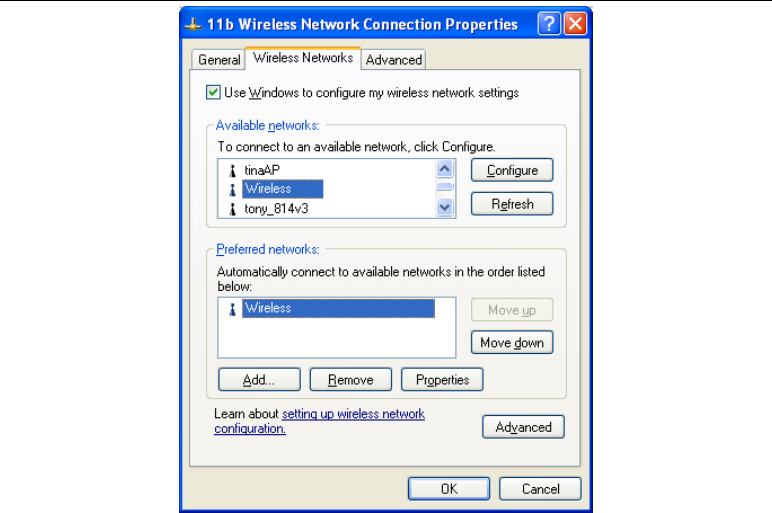
Click OK to establish a connection to the Wireless ADSL Router.
22
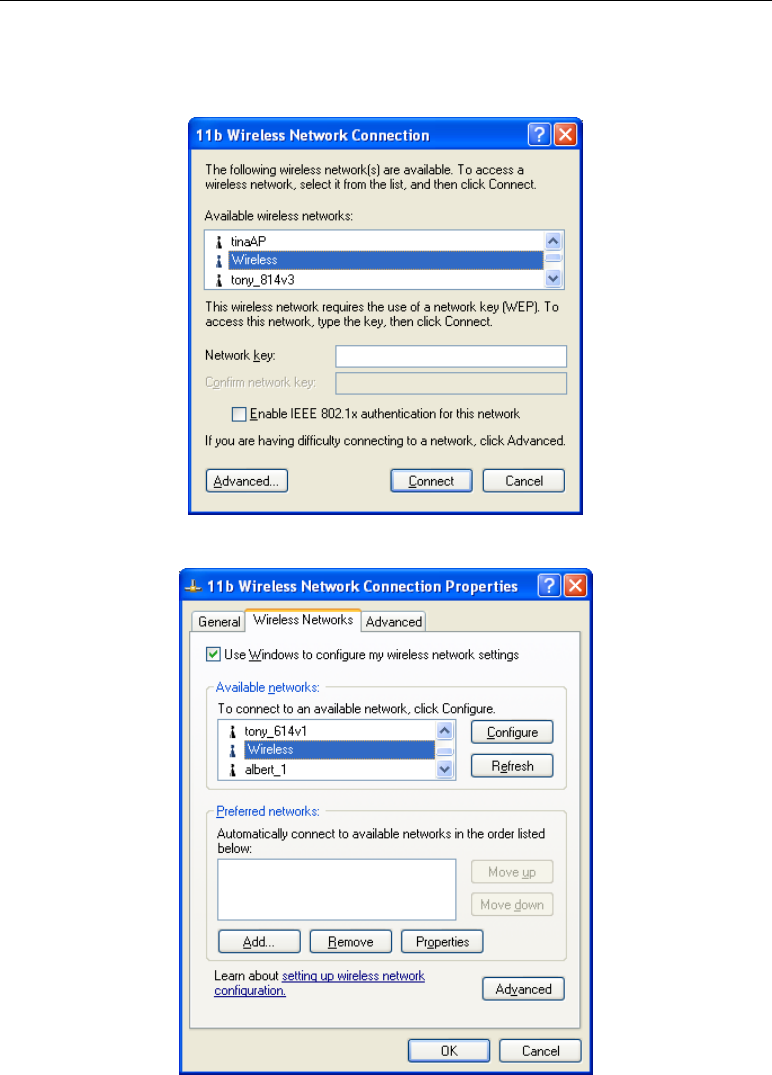
If using WPA-PSK Data Encryption
If WPA-PSK data encryption has been enabled on the Wireless ADSL Router, it does not
matter which network is selected on the screen below. Just click the Advanced button.
You will then see a screen like the example below.
Select the SSID for the Wireless ADSL Router, and click Configure, to see a screen like the
following:
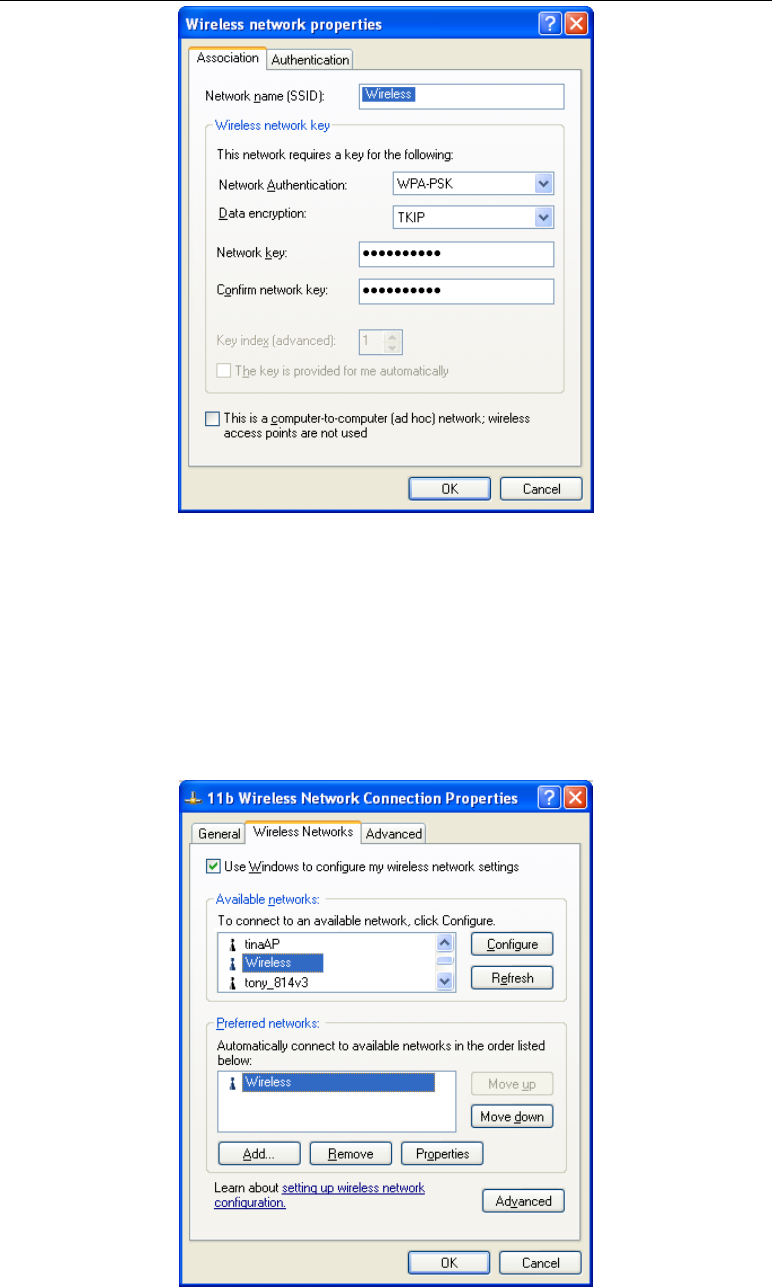
Configure this screen as follows:
• Set Network Authentication to WPA-PSK.
• For Data Encryption, select TKIP.
• For the Network key and Confirm network key, enter the network key (PSK) used on the
Wireless ADSL Router.
• Ensure the option This is a computer-to-computer (ad hoc) network is unchecked.
• Click OK to save and close this dialog.
• This wireless network will now be listed in Preferred Networks on the screen below.
Click OK to establish a connection to the Wireless ADSL Router.
24
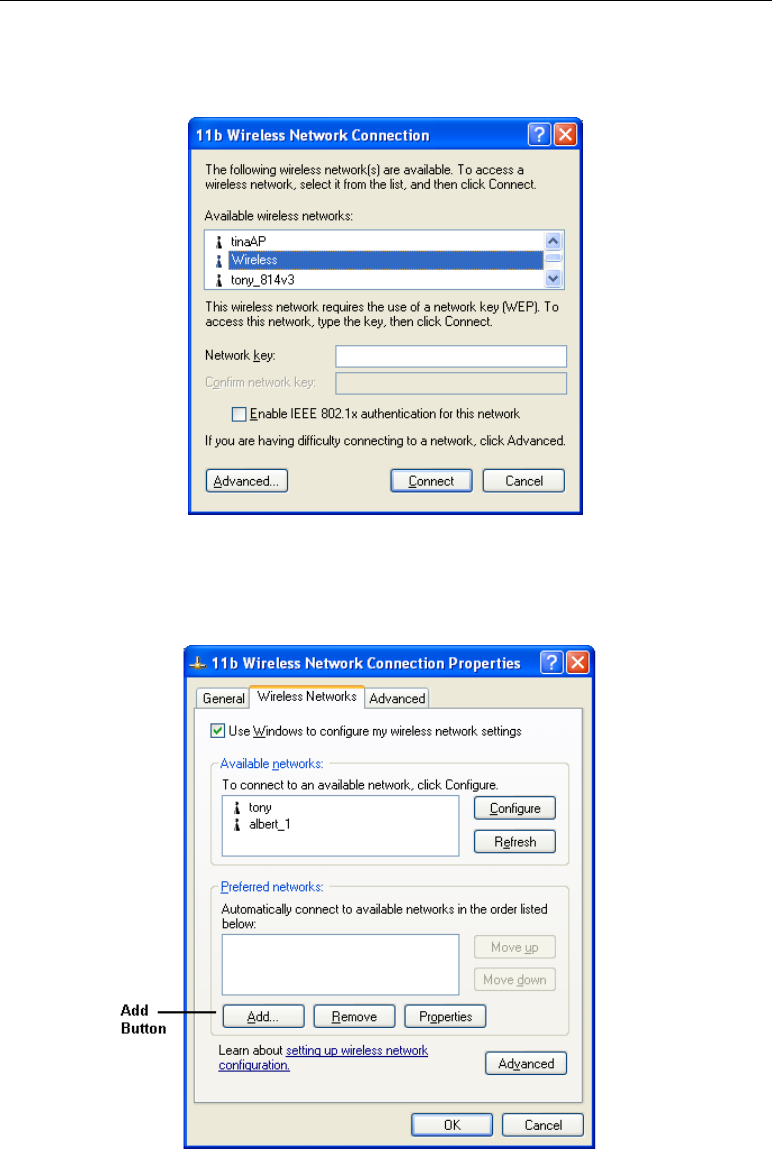
If the SSID is not listed
If the "Broadcast SSID" setting on the Wireless ADSL Router has been disabled, its SSID will
NOT be listed on the screen below.
In this situation, you need to obtain the SSID from your network administrator, then follow
this procedure:
1. Click the Advanced button to see a screen like the example below.
2. Click the Add button. You will see a screen like the example below.
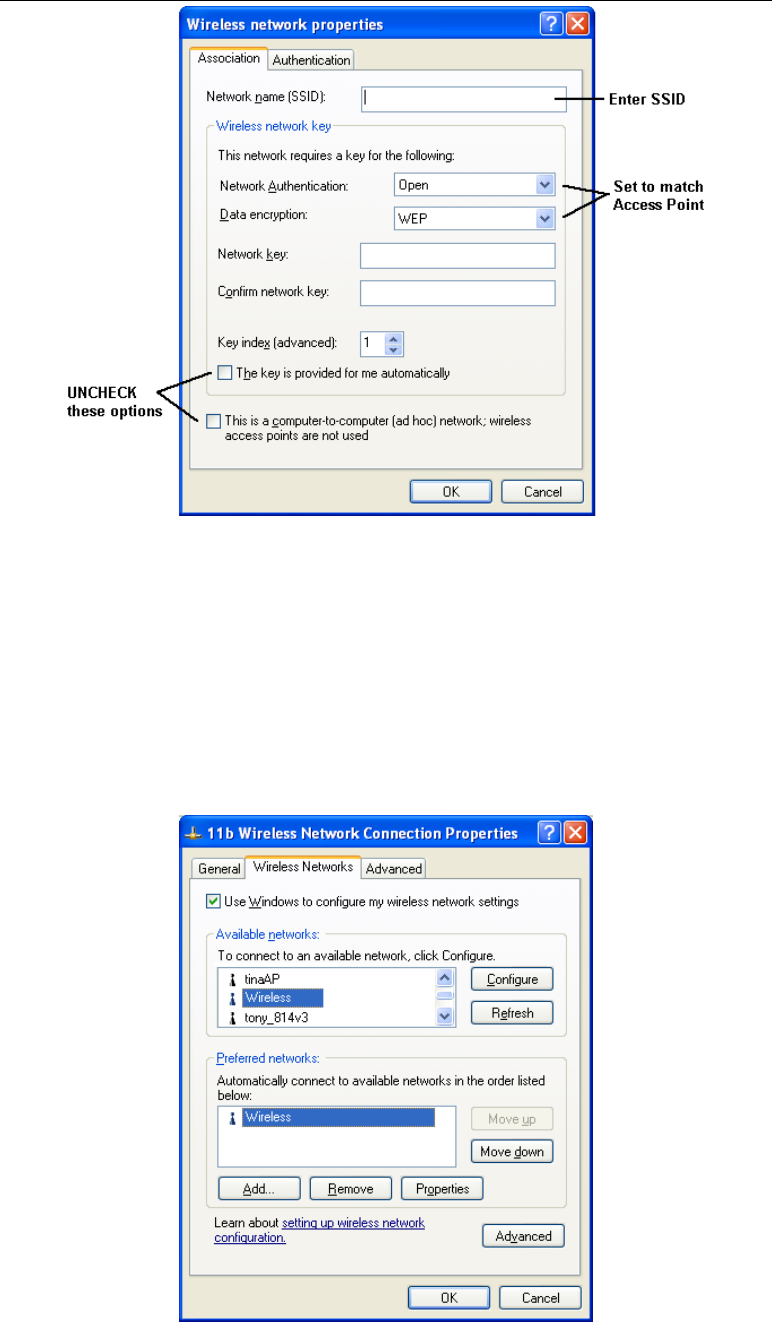
3. Configure this screen as follows:
• Enter the correct SSID, as used on the Wireless ADSL Router. Remember the SSID is
case-sensitive, so be sure to match the case, not just the spelling.
• Set Network Authentication and Data Encryption to match the Wireless ADSL Router.
• If using data encryption (WEP or WPA-PSK), enter the key used on the Wireless
ADSL Router. See the preceding sections for details of WEP and WPA-PSK.
• Uncheck the options The key is provided for me automatically and This is a comput-
er-to-computer (ad hoc) network.
• Click OK to save and exit.
4. This wireless network will then be listed in Preferred Networks on the screen below.
5. Click OK to establish a connection to the Wireless ADSL Router.
26
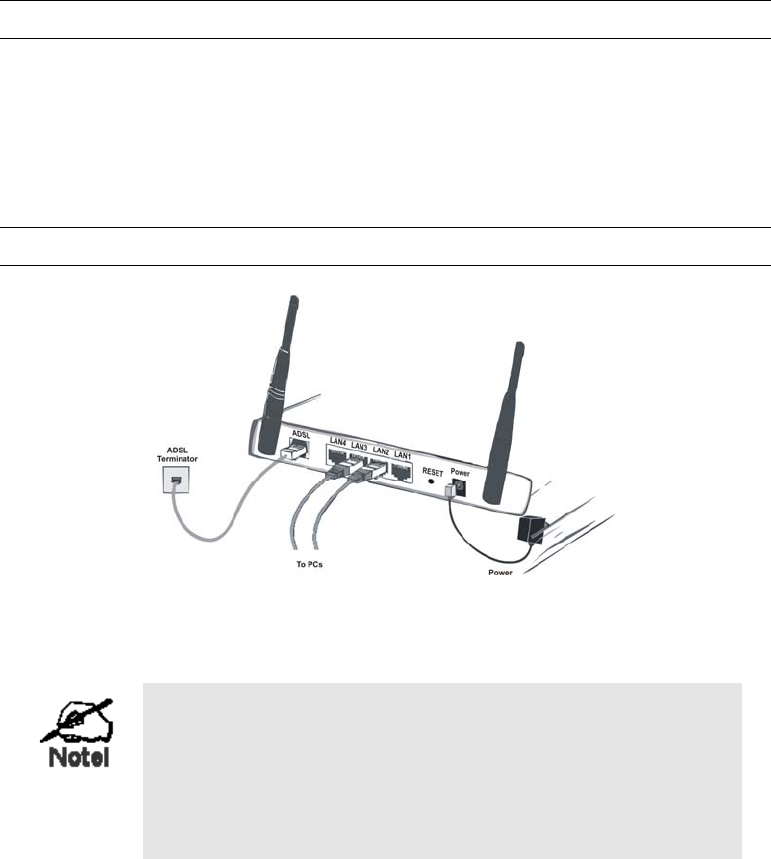
Installation
Requirements
• Network cables. Use standard 10/100BaseT network (UTP) cables with RJ45 connectors.
• TCP/IP protocol must be installed on all PCs.
• For Internet Access, an Internet Access account with an ISP, and a DSL connection.
• To use the Wireless Access Point, all Wireless devices must be compliant with the IEEE
802.11g, IEEE 802.11b or IEEE 802.11n Draft specifications.
Procedure
1. Choose an Installation Site
Select a suitable place on the network to install the Wireless ADSL Router.
For best Wireless reception and performance, the Wireless
ADSL Router should be positioned in a central location with
minimum obstructions between the Wireless ADSL Router
and the PCs.
Also, if using multiple Access Points, adjacent Access
Points should use different Channels.
2. Connect LAN Cables
Use standard LAN cables to connect PCs to the Switching Hub ports on the Wireless
ADSL Router. Both 10BaseT and 100BaseT connections can be used simultaneously.
If required, connect any port to a normal port on another Hub, using a standard LAN cable.
3. Connect ADSL Cable
Connect the supplied ADSL cable from to the ADSL port on the Wireless ADSL Router
(the RJ11 connector) to the ADSL terminator provided by your phone company.
27

28
4. Power Up
Connect the supplied power adapter to the Wireless ADSL Router. Use only the power
adapter provided. Using a different one may cause hardware damage.
5. Check the LEDs
• The Power LED should be ON.
• For each LAN (PC) connection, one of the LAN LEDs should be ON (provided the PC is
also ON.)
• The WLAN LED should be ON
• The ADSL LED should be ON if ADSL line is connected.
• The Internet LED may be OFF. After configuration, it should come ON.
For more information, refer to Front-mounted LEDs in page 4.

Setup
Overview
This chapter describes the setup procedure for:
• Internet Access
• LAN configuration
• Wireless setup
• Assigning a Password to protect the configuration data.
PCs on your local LAN may also require configuration. For details, see Chapter 4 - PC Confi-
guration.
Other configuration may also be required, depending on which features and functions of the
Wireless ADSL Router you wish to use. Use the table below to locate detailed instructions for
the required functions.
To Do this: Refer to:
Configure PCs on your LAN. Chapter 4:
PC Configuration
Check Wireless ADSL Router operation and Status. Chapter 5:
Operation and Status
Use any of the following Advanced features:
• Internet (DMZ, URL Filter)
• Access Control
• Dynamic DNS
• Options
• Schedule
• Port Trigger
• Port Forward
• Port Range Forward
• QoS
Chapter 6:
Advanced Features
Use any of the following Administration Configuration
settings or features:
• PC Database
• Config File
• Logging
• E-mail
• Diagnostics
• Remote Admin
• Routing
• Upgrade Firmware
Chapter 7
Advanced Administration
29

30
Configuration Program
The Wireless ADSL Router contains an HTTP server. This enables you to connect to it, and
configure it, using your Web Browser. Your Browser must support JavaScript.
The configuration program has been tested on the following browsers:
• Netscape 7.1 or later.
• Mozilla 1.6 or later
• Internet Explorer V5.5 or later
Preparation
Before attempting to configure the Wireless ADSL Router, please ensure that:
• Your PC can establish a physical connection to the Wireless ADSL Router. The PC and
the Wireless ADSL Router must be directly connected (using the Hub ports on the Wire-
less ADSL Router) or on the same LAN segment.
• The Wireless ADSL Router must be installed and powered ON.
• If the Wireless ADSL Router's default IP Address (192.168.0.1) is already used by anoth-
er device, the other device must be turned OFF until the Wireless ADSL Router is
allocated a new IP Address during configuration.
Using your Web Browser
To establish a connection from your PC to the TEW-635BRM:
6. After installing the TEW-635BRM in your LAN, start your PC. If your PC is already
running, restart it.
7. Start your WEB browser.
8. In the Address box, enter "HTTP://" and the IP Address of the TEW-635BRM, as in this
example, which uses the Wireless ADSL Router's default IP Address:
HTTP://192.168.10.1
9. When prompted for the User name and Password, enter values as follows:
• User name admin
• Password admin

If you can't connect
If the Wireless ADSL Router does not respond, check the following:
• The Wireless ADSL Router is properly installed, LAN connection is OK, and
it is powered ON. You can test the connection by using the "Ping" command:
• Open the MS-DOS window or command prompt window.
• Enter the command:
ping 192.168.10.1
If no response is received, either the connection is not working, or your
PC's IP address is not compatible with the Wireless ADSL Router's IP
Address. (See next item.)
• If your PC is using a fixed IP Address, its IP Address must be within the range
192.168.10.2 to 192.168.10.254 to be compatible with the Wireless ADSL
Router's default IP Address of 192.168.10.1. Also, the Network Mask must be
set to 255.255.255.0. See Chapter 4 - PC Configuration for details on check-
ing your PC's TCP/IP settings.
• Ensure that your PC and the Wireless ADSL Router are on the same network
segment. (If you don't have a router, this must be the case.)
• Ensure you are using the wired LAN interface. The Wireless interface can only
be used if its configuration matches your PC's wireless settings.
Setup Wizard
The first time you connect to the Wireless ADSL Router, you should run the Setup Wizard to
configure the ADSL and Internet Connection.
1. Click the Setup Wizard link on the main menu and click “Next”.
2. On the below screen, select Auto-detect or Manual Selection, then click "Next"
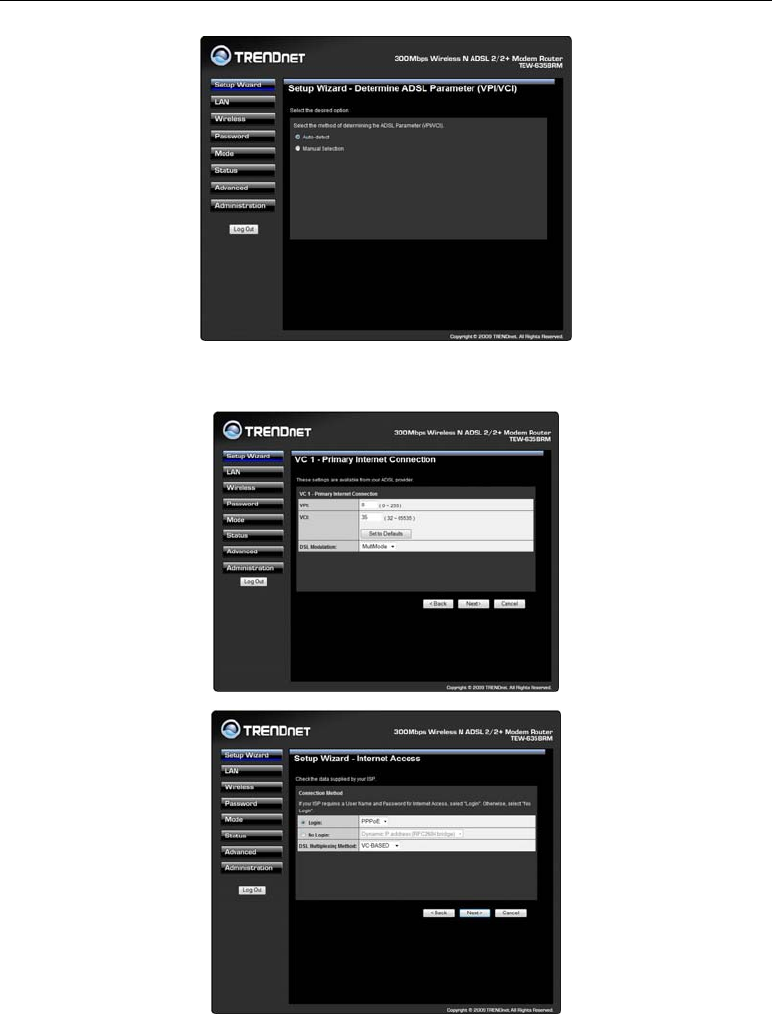
3. If Manual Selection is selected, you will see the VC 1 screen shown below. Enter the VPI
and VCI values provided by your ISP, then click "Next".
4. On the Internet Access Screen, shown above, select the correct connection type, as used
by your ISP. Click "Next" and complete the configuration for your connection method.
• You need the data supplied by your ISP. Your ISP's data will also have the DSL Mul-
tiplexing Method ( LLC or VC )
• The common connection types are explained in the following table..
32

Connection Type Details ISP Data required
Dynamic
IP Address Your IP Address is allocated
automatically, when you con-
nect to you ISP.
Often, none.
Some ISP's may require you to
use a particular Hostname or
Domain name, or MAC (physical)
address.
Static (Fixed)
IP Address Your ISP allocates a permanent
IP Address to you.
Usually, the connection is
"Always on".
IP Address allocated to you, and
related information, such as
Network Mask, Gateway IP
address, and DNS address.
PPPoE, PPPoA You connect to the ISP only
when required. The IP address
is usually allocated automatical-
ly.
a) User name and password are
always required.
b) If using a Static (Fixed) IP
address, you need the IP address
and related information (Network
Mask, Gateway IP address, and
DNS address)
IPoA
(IP over ATM) Normally, the connection is
"Always on". IP Address allocated to you, and
related information, such as
Network Mask, Gateway IP
address, and DNS address.
5. Step through the Wizard until finished.
6. On the final screen of the Wizard, run the test and check that an Internet connection can be
established.
7. If the connection test fails:
• Check all connections, and the front panel LEDs.
• Check that you have entered all data correctly.
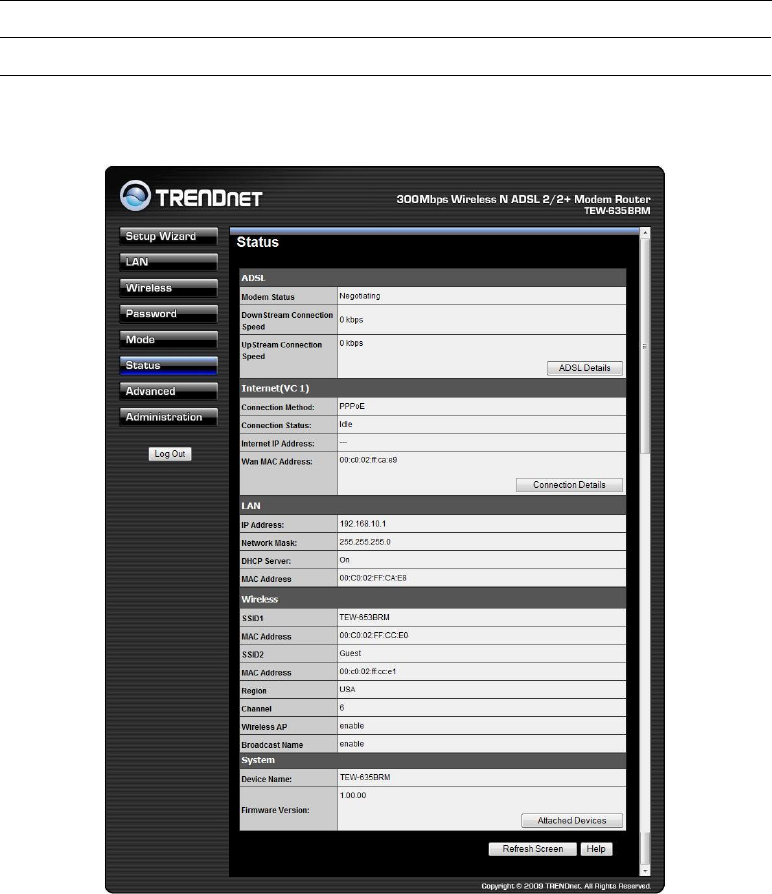
Home Screen
After finishing the Setup Wizard, you will see the Home screen. When you connect in future,
you will see this screen when you connect. An example screen is shown below.
Main Menu
The main menu, on the left, contains links to the most-commonly used screen. To see the links
to the other available screens, click "Advanced" or "Administration".
The main menu also contains two (2) buttons:
• Log Out - When finished, you should click this button to logout.
Navigation & Data Input
• Use the menu bar on the left of the screen, and the "Back" button on your Browser, for
navigation.
• Changing to another screen without clicking "Save" does NOT save any changes you may
have made. You must "Save" before changing screens or your data will be ignored.
34

On each screen, clicking the "Help" button will
display help for that screen.

LAN Screen
Use the LAN link on the main menu to reach the LAN screen. An example screen is shown
below.
Data - LAN Screen
TCP/IP
IP Address IP address for the Wireless ADSL Router, as seen from the local LAN.
Use the default value unless the address is already in use or your LAN
is using a different IP address range. In the latter case, enter an unused
IP Address from within the range used by your LAN.
Subnet Mask The default value 255.255.255.0 is standard for small (class "C")
networks. For other networks, use the Subnet Mask for the LAN
segment to which the Wireless ADSL Router is attached (the same
value as the PCs on that LAN segment).
DHCP Server • If Enabled, the Wireless ADSL Router will allocate IP Addresses
to PCs (DHCP clients) on your LAN when they start up. The de-
fault (and recommended) value is Enabled.
• If you are already using a DHCP Server, this setting must be
Disabled, and the existing DHCP server must be re-configured to
treat the Wireless ADSL Router as the default Gateway. See the
following section for further details.
• The Start IP Address, Finish IP Address and Lease Time fields
set the values used by the DHCP server when allocating IP Ad-
dresses to DHCP clients. This range also determines the number of
DHCP clients supported.
See the following section for further details on using DHCP.
36

DHCP
What DHCP Does
A DHCP (Dynamic Host Configuration Protocol) Server allocates a valid IP address to a
DHCP Client (PC or device) upon request.
• The client request is made when the client device starts up (boots).
• The DHCP Server provides the Gateway and DNS addresses to the client, as well as
allocating an IP Address.
• The Wireless ADSL Router can act as a DHCP server.
• Windows 95/98/ME and other non-Server versions of Windows will act as a DHCP client.
This is the default Windows setting for the TCP/IP network protocol. However, Windows
uses the term Obtain an IP Address automatically instead of "DHCP Client".
• You must NOT have two (2) or more DHCP Servers on the same LAN segment. (If your
LAN does not have other Routers, this means there must only be one (1) DHCP Server on
your LAN.)
Using the Wireless ADSL Router's DHCP Server
This is the default setting. The DHCP Server settings are on the LAN screen. On this screen,
you can:
• Enable or Disable the Wireless ADSL Router's DHCP Server function.
• Set the range of IP Addresses allocated to PCs by the DHCP Server function.
You can assign Fixed IP Addresses to some devices
while using DHCP, provided that the Fixed IP Addresses
are NOT within the range used by the DHCP Server.
Using another DHCP Server
You can only use one (1) DHCP Server per LAN segment. If you wish to use another DHCP
Server, rather than the Wireless ADSL Router's, the following procedure is required.
• Disable the DHCP Server feature in the Wireless ADSL Router. This setting is on the
LAN screen.
• Configure the DHCP Server to provide the Wireless ADSL Router's IP Address as the
Default Gateway.
To Configure your PCs to use DHCP
This is the default setting for TCP/IP for all non-Server versions of Windows.
See Chapter 4 - Client Configuration for the procedure to check these settings.
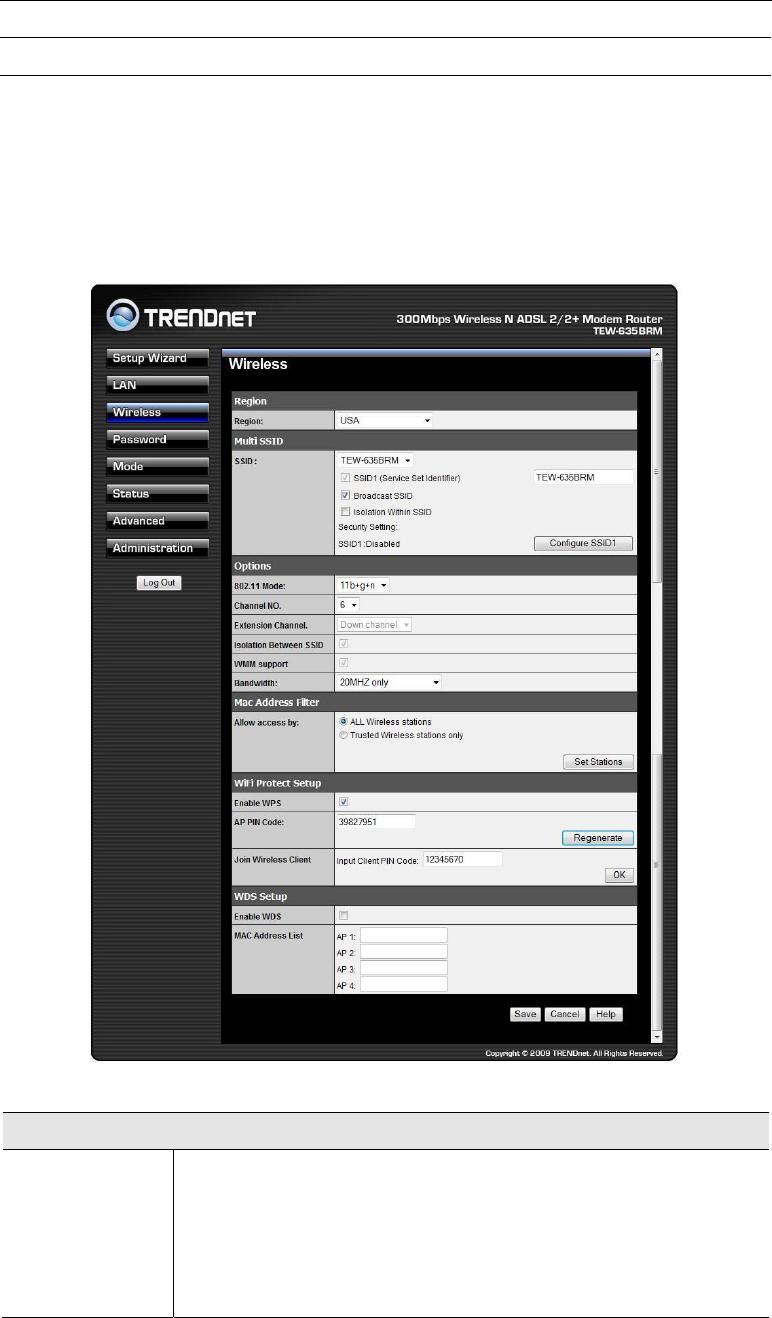
Wireless Screen
The Wireless ADSL Router's settings must match the other Wireless stations.
Note that the Wireless ADSL Router will automatically accept both 802.11b and 802.11g
connections, and no configuration is required for this feature.
To change the Wireless ADSL Router's default settings for the Wireless Access Point feature,
use the Wireless link on the main menu to reach the Wireless screen. An example screen is
shown below.
Data - Wireless Screen
Region
Region Select the correct domain for your location. It is your responsibility to
ensure:
• That the Wireless ADSL Router is only used in domains for which
is licensed.
• That you select the correct domain, so that only the legal channels
for that domain can be selected.
38

Multi SSID
SSID With Multiple SSIDs, you can have 2 SSIDs on one AP. For example,
a Guest SSID without encryption for visitors to have Internet access
only, and a Admin SSID with encryption for private use to secure your
company resources.
Select the desired SSID from the list to configure.
SSID 1/2 This is also called the "Network Name".
• If using an ESS (Extended Service Set, with multiple access
points) this ID is called an ESSID (Extended Service Set Identifi-
er).
• To communicate, all Wireless stations should use the same
SSID/ESSID.
Broadcast SSID If enabled, the Wireless ADSL Router will broadcast its SSID. This
allows PCs and other wireless stations to detect this Access Point and
use the correct SSID.
If disabled, PC users will have to manually enter the SSID and other
details of the wireless interface before they can connect to this Access
Point.
Isolation within
SSID If Enabled, devices that have the same SSID will not be able to see
each other.
Security Setting The current Wireless security is displayed. The default value is Dis-
abled.
Configure SSID
1/2 Button Click this button to access the Wireless security sub-screen, and view
or change the settings. See the following section for details.
Options
802.11 Mode Select the desired mode:
• Off - Wireless is disabled.
• B only - Only 802.11b connections are available. 802.11g Wire-
less Stations will only be able to use the Wireless Router if they
are fully backward-compatible with the 802.11b standard.
• G only - Only 802.11g Wireless stations can use the Wireless
Router.
• 11b/g/n - 802.11.g, 802.11b and 802.11n Wireless stations can use
the Wireless Broadband Router.
Channel NO. Select the Channel you wish to use on your Wireless LAN.
• If you experience interference (shown by lost connections and/or
slow data transfers) you may need to experiment with different
channels to see which is the best.
• If using multiple Access Points, adjacent Access Points should use
different Channels to reduce interference.
Isolation
between SSID If Enabled, devices that have the different SSIDs will not be able to
communicate with each other.
WMM Support Enable or disable this feature as required.
Bandwidth Select the desired bandwidth from the list.

40
MAC Address Filter
Allow access
by … Use this feature to determine which Wireless stations can use the
Access Point. The options are:
• All Wireless Stations - All wireless stations can use the access
point, provided they have the correct SSID and security settings.
• Trusted Wireless stations only - Only wireless stations you
designate as "Trusted" can use the Access Point, even if they have
the correct SSID and security settings.
This feature uses the MAC address to identify Wireless stations.
The MAC address is a low-level network identifier which is
unique to each PC or network device.
To define the trusted wireless stations, use the "Set Stations" but-
ton.
Set Stations
Button Click this button to manage the trusted PC database.
WiFi Protect Setup
Enable WPS Enable this if you want to use Wireless WPS function.
AP PIN Code Use the default displayed value or click the Regenerate button to have
the new pin code in the field.
Input Client PIN
Code Enter the client’s PIN code in the field and click OK to add the client
device.
WDS
Enable WDS This feature allows you to make a completely wireless network by
using multiple access points without connecting them with a wire
LAN.
In order to make the WDS working successfully, the access point must
use the same channel, SSID, as well as the wireless encryption method.
MAC Address
List Enter the MAC address(es) of the AP(s) into the fields to allow the
following access points to be connected to the wireless router.
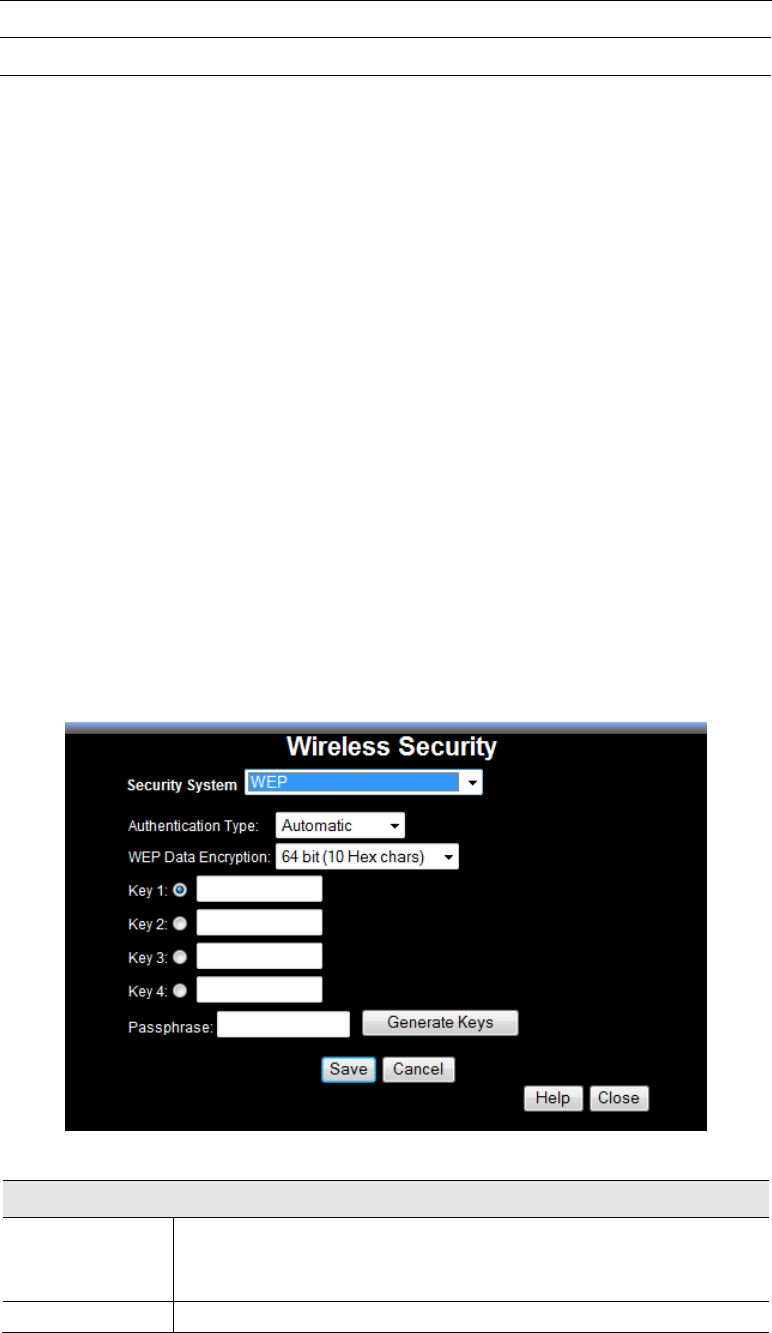
Wireless Security
This screen is accessed by clicking the "Configure SSID" button on the Wireless screen. There
are 6 options for Wireless security:
• Disabled - no data encryption is used.
• WEP - data is encrypted using the WEP standard.
• WPA-PSK - data is encrypted using the WPA-PSK standard. This is a later standard than
WEP, and provides much better security than WEP. If all your Wireless stations support
WPA-PSK, you should use WPA-PSK rather than WEP.
• WPA2-PSK - This is a further development of WPA-PSK, and offers even greater securi-
ty, using the AES (Advanced Encryption Standard) method of encryption.
• WPA-PSK and WPA2-PSK - This method, sometimes called "Mixed Mode", allows
clients to use EITHER WPA-PSK OR WPA2-PSK.
• 802.1x - This uses the 802.1x standard for client authentication, and WEP for data encryp-
tion.
If this option is selected:
• This Access Point must have a "client login" on the Radius Server.
• Each user must have a "user login" on the Radius Server.
• Each user's wireless client must support 802.1x and provide the login data when re-
quired.
• All data transmission is encrypted using the WEP standard. You only have to select
the WEP key size; the WEP key is automatically generated.
WEP Wireless Security
Data - WEP Screen
WEP Data Encryption
Authentication
Type Normally, this should be left at the default value of "Automatic". If
changed to "Open System" or "Shared Key", ensure that your Wireless
Stations use the same setting.
WEP Data Select the desired option, and ensure the Wireless Stations use the
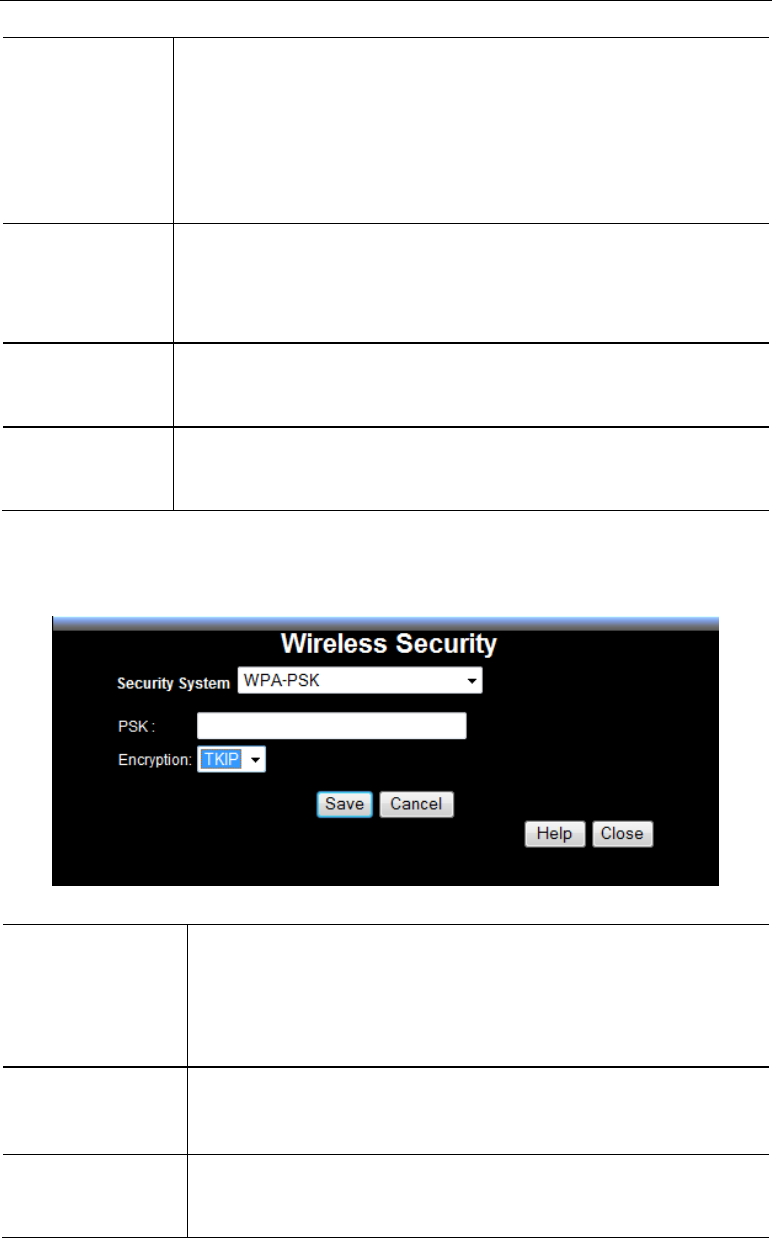
Encryption same setting.
• 64 Bit - data is encrypted, using the default key, before being
transmitted. You must enter at least the default key. For 64 Bit En-
cryption, the key size is 10 chars in HEX (0~9 and A~F).
• 128 Bit - data is encrypted, using the default key, before being
transmitted. You must enter at least the default key. For 128 Bit
Encryption, the key size is 26 chars in HEX (0~9 and A~F).
Default Key Select the key you wish to be the default. Transmitted data is
ALWAYS encrypted using the Default Key; the other Keys are for
decryption only.
You must enter a Key Value for the Default Key.
Key Value Enter the key value or values you wish to use. The Default Key is
required, the other keys are optional. Other stations must have the
same key.
Passphrase If desired, you can generate a key from a phrase, instead of entering
the key value directly. Enter the desired phrase, and click the "Gener-
ate Keys" button.
WPA-PSK Wireless Security
Data - WPA-PSK Screen
Security
System WPA-PSK
Like WEP, data is encrypted before transmission. WPA is more
secure than WEP, and should be used if possible. WPA-PSK is the
version of WPA, which does NOT require a Radius Server on your
LAN.
PSK Enter the PSK (network key). Data is encrypted using a key derived
from the network key. Other Wireless Stations must use the same
network key. The PSK must be from 8 to 63 characters in length.
WPA Encryption The WPA-PSK standard allows different encryption methods to be
used. Select the desired option. Wireless Stations must use the same
encryption method.
42
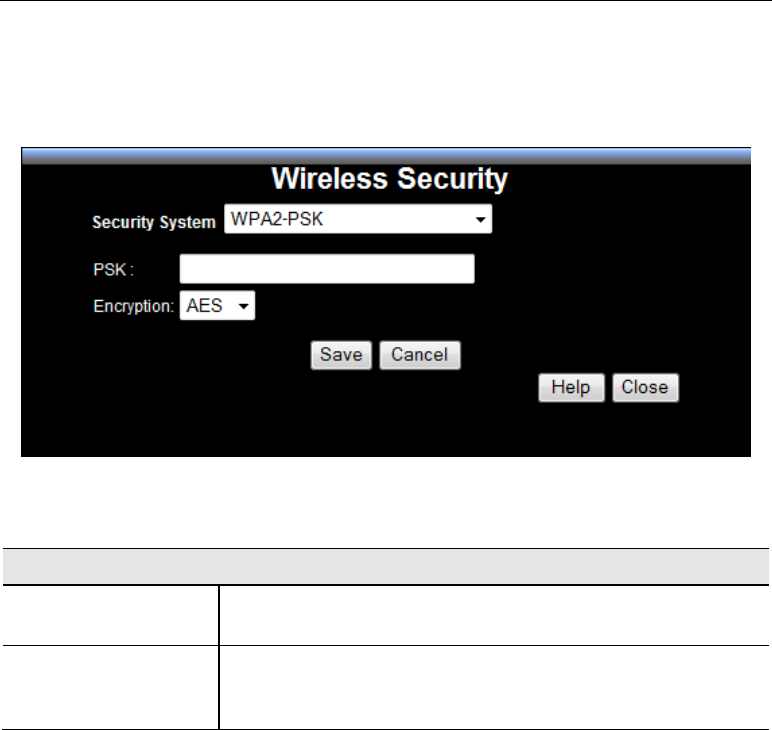
Security Settings - WPA2-PSK
This is a further development of WPA-PSK, and offers even greater security, using the AES
(Advanced Encryption Standard) method of encryption.
Figure 1: WPA2-PSK Wireless Security Screen
Data - WPA2-PSK Screen
WPA2-PSK
PSK Enter the key value. Data is encrypted using a 256Bit key derived
from this key. Other Wireless Stations must use the same key.
Encryption The WPA2-PSK standard allows different encryption methods to
be used. Select the desired option. Wireless Stations must use the
same encryption method.
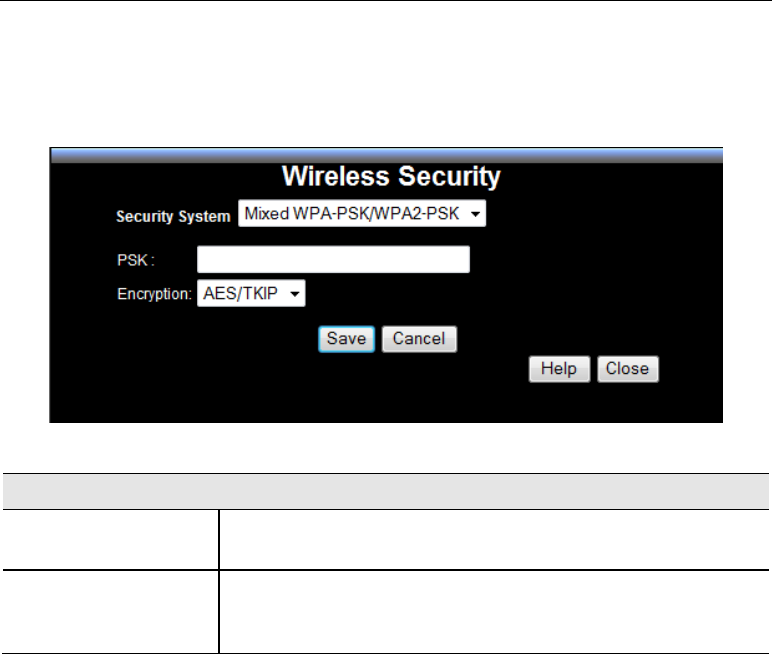
Security Settings - Mixed WPA-PSK/WPA2-PSK
This method, sometimes called "Mixed Mode", allows clients to use EITHER WPA-PSK OR
WPA2-PSK.
Data - WPA2-PSK Screen
WPA2-PSK
PSK Enter the key value. Data is encrypted using a 256Bit key derived
from this key. Other Wireless Stations must use the same key.
Encryption This standard allows different encryption methods to be used.
Select the desired option. Wireless Stations must use the same
encryption method.
44
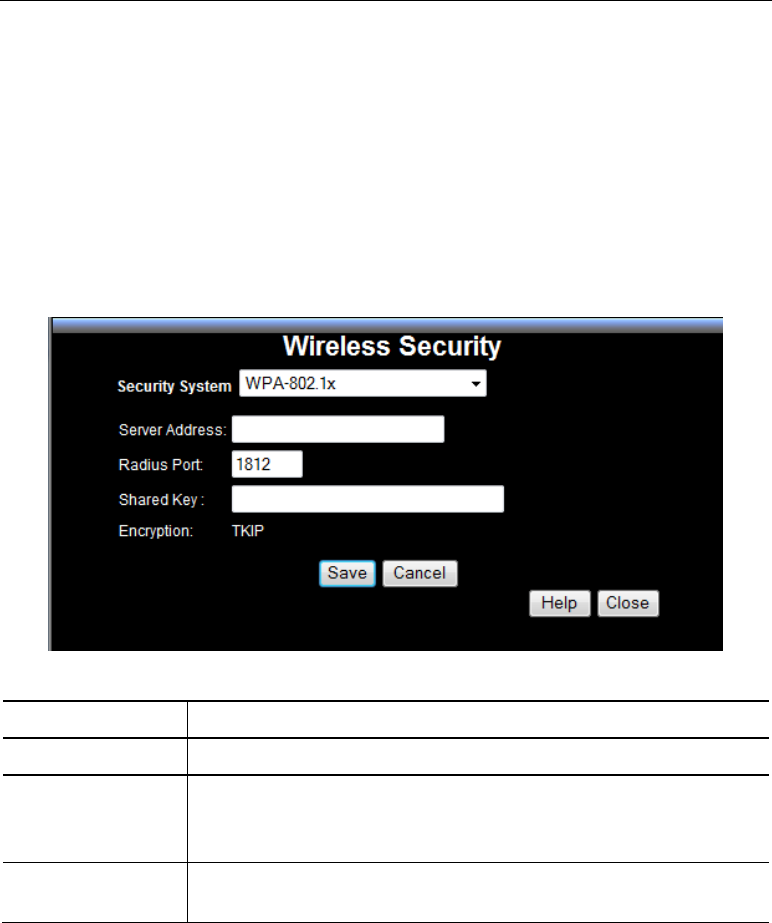
Security Settings - 802.1x
This uses the 802.1x standard for client authentication, and WEP for data encryption. If this
option is selected:
• This Access Point must have a "client login" on the Radius Server.
• Each user must have a "user login" on the Radius Server. Normally, a Certificate is used to
authenticate each user. See Chapter4 for details of user configuration.
• Each user's wireless client must support 802.1x.
• All data transmission is encrypted using the WEP standard. You only have to select the
WEP key size; the WEP key is automatically generated.
Data - 802.1x Screen
Server Address Enter the server address here.
Radius Port Enter the port number used for connections to the Radius Server.
Shared Key Enter the shared key. Data is encrypted using a key derived from the
network key. Other Wireless Stations must use the same key. The
key must be from 8 to 63 characters in length.
Encryption The encryption method is TKIP. Wireless Stations must also use
TKIP.
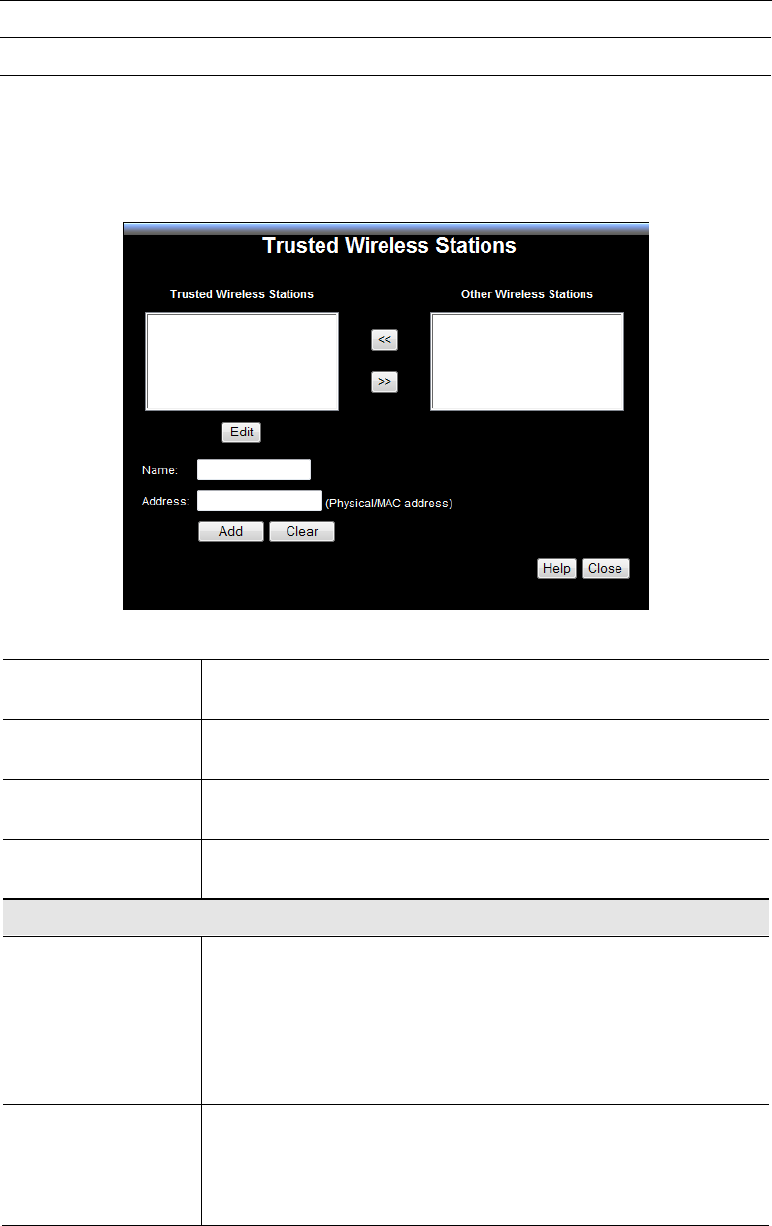
Trusted Wireless Stations
This feature can be used to prevent unknown Wireless stations from using the Access Point.
This list has no effect unless the setting Allow access by trusted stations only is enabled.
To change the list of trusted wireless stations, use the Modify List button on the Access Control
screen. You will see a screen like the sample below.
Data - Trusted Wireless Stations
Trusted Wireless
Stations This lists any Wireless Stations which you have designated as
“Trusted”.
Other Wireless
Stations This list any Wireless Stations detected by the Access Point, which
you have not designated as "Trusted".
Name The name assigned to the Trusted Wireless Station. Use this when
adding or editing a Trusted Station.
Address The MAC (physical) address of the Trusted Wireless Station. Use
this when adding or editing a Trusted Station.
Buttons
<< Add a Trusted Wireless Station to the list (move from the "Other
Stations" list).
• Select an entry (or entries) in the "Other Stations" list, and
click the " << " button.
• Enter the Address (MAC or physical address) of the wireless
station, and click the "Add " button.
>> Delete a Trusted Wireless Station from the list (move to the "Other
Stations" list).
• Select an entry (or entries) in the "Trusted Stations" list.
• Click the " >> " button.
46

Edit Use this to change an existing entry in the "Trusted Stations" list:
1. Select the Station in the Trusted Station list.
2. Click the Edit button. The address will be copied to the "Ad-
dress" field, and the Add button will change to Update.
3. Edit the address (MAC or physical address) as required.
4. Click Update to save your changes.
Add (Update) To add a Trusted Station which is not in the "Other Wireless
Stations" list, enter the required data and click this button.
When editing an existing Wireless Station, this button will change
from Add to Update.
Clear Clear the Name and Address fields.